

30 Years of Protecting Monterey Bay THE SANCTUARY PACKRAFTING MAJESTIC INYO HIKES SACHI CUNNINGHAM EQUAL PAY JENNIFER MAXWELL ENERGY BAR PIONEER Stop Sargent Quarry









































2 ASJ — June/July 2022 Use your outside voice. Everything is #GreaterOutdoors Find Gear Coop on social @gearcoop or shop Merrell at gearcoop.com

www.adventuresportsjournal.com 3 MAKALU FX CARBON
GUIDE YOUR WAY. MIRNA VALERIO “The Mirnavator”
departments
features

Go Farther and Relax Easier
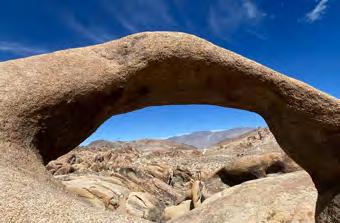



4 ASJ — June/July 2022 © 2022 Eagles Nest Outfitters, Inc.
Whether on a multi-day trip, or cruising around town, the TechNest Hammock provides the perfect space to rest and recover. It’s low profile and lightweight design make this feature-packed hammock your go-to pedaling companion. enonation.com IN THIS ISSUE June/July 2022, #124
ON THE COVER: A California sea lion,
Zalophus
californianus, swims above a SCUBA diver along the central California coast.
Photo by Jim Patterson / TandemStock. com
10 Stop Sargent Quarry The Amah Mutsun Tribal Band needs support // 12 Inyo County Hikes Moderate majesty for adventurous hikers // 16 Packrafting Changing backcountry exploration // 26 Sachi Cunningham Telling the story of women’s big wave surfing // 28 Energy Bar Pioneer Jennifer Maxwell’s new JAMBAR // 30 Stetina’s Paydirt Gravel cycling event in Carson City
EPiC Monterey Bay National Marine Sanctuary // 31 Race Calendar Upcoming events
7 Editor’s Note Soul // 8 Inbox Letters & opinions // 8 Ear to the Ground News & notes // 15 Earn Your Beer Kayaking San Diego’s Mission Bay // 20
26
20 10 12
PHOTO CREDITS: (20) Douglas Croft; (26) Sachi Cunningham; (10) Tyler Kendrick; (12) Matt Johanson

www.adventuresportsjournal.com 5
MERIT SPHERICAL HELMET
PUBLISHING + EDITORIAL
PUBLISHER
Cathy Claesson cathy@adventuresportsjournal.com
EDITOR-IN-CHIEF
Matt Niswonger matt@adventuresportsjournal.com
EDITOR
Michele Lamelin michele@adventuresportsjournal.com
COPY EDITOR
Jennifer Stein jen@adventuresportsjournal.com
SOCIAL MEDIA MANAGER
Marissa Neely marissa@asjmag.com
CONTRIBUTING PHOTOGRAPHERS
Alexii Sigona, Tyler Kendrick, Nick Paz, Sachi Cunningham, Matt Johanson, Chad King, Kathryn Hoffman, Steve Lonhart, Douglas Croft, Kameron Strickland, Robin Levick, John Baker, Gareth Tate/Astral, Luk Mehl

LAYOUT
Cathy Claesson
COVER DESIGN
Lauren Worth
asj contributors
How can we make amends to the native people whose ancestors lived in the places we play?
leoniesherman

We may never be able to make amends for the suffering caused by genocide and colonization. But we can start by learning about native culture and history, centering native perspectives and amplifying voices.
mattjohanson
We can honor them by treading lightly, treating others kindly, being honest about the history and using Indigenous names, when known.
kurtgensheimer
Where it makes sense, the concept of renaming certain locations using Native American language is a good way to pay honor and respect.
anthearaymond
ADVERTISING
ACCOUNT EXECUTIVE

Cathy Claesson I 831.234.0351 cathy@adventuresportsjournal.com


EVENTS & DISTRIBUTION


Matt Niswonger matt@adventuresportsjournal.com



EVENTS MARKETING
Michele Lamelin michele@adventuresportsjournal.com


Jennifer Stein jen@adventuresportsjournal.com
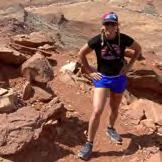
Opinions expressed are those of the authors and not necessarily those of Adventure Sports Journal or our advertisers. We usually agree with our articles, but sometimes we don’t. We welcome all contributions.



All content © Adventure Sports Journal 2022. No part of this publication may be reproduced without permission of the editors
ADVENTURE SPORTS JOURNAL

PO BOX 35, Santa Cruz, CA 95063 Phone 831.457.9453
asjstaff@adventuresportsjournal.com
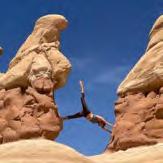

PROUD MEMBER
We can’t ever make amends. Best we can do is remember: we are guests, we need to do what we can to respect and understand more about those on whose history we stand.

kristahoughton
Leave it better than how you found it. Pick up any trash, erase evidence of recreational impact, such as tire ruts or makeshift fire rings. Always have respect for the land.
jamesmurren
Government pay back what was stolen. Education. Read Vine Deloria Jr.’s Custer Died for Your Sins. When recreating, stop thinking we might be the first to ever set foot on a place. Nearly all of us are retracing native people’s footsteps.
jimscripps
Acknowledge the history while using land and resources in a way that is respectful and sustainable. If we do it right, future generations will understand and honor the lineage that connects the past, present and future.
mattniswonger
We can’t fully make amends, but we can help dismantle white supremacy by participating in events like the Remembrance Run, the Salmon Run and the Siren run.

6 ASJ — June/July 2022
CENTRAL SIERRA NEVADA WWW.BVADVENTURES.COM MT. BIKE • CYCLING • BIKE SHOP KAYAK • CANOE • SUP RENTALS FISHING • CAMPING • CAFE ride with us. ride better. asingletrackmind.com (209) 662-5392 Racing professionally since 2001. Professionally coaching since 2009. Gold standard of certifications: USA Cycling, BICP level 3, BetterRide, NICA, NASM, WFR. MTB Skills Coaching Scan here!
Soul The reason we exist EDITOR’S

Recently I was thinking about the origins of Adventure Sports Journal. Way back in the late 1990s, we were a young outdoorsy couple living in Santa Cruz. We were ambitious and idealistic, and we wanted to make a career in the outdoor recreation industry. So in 2001 we started a free adventure magazine along with our partner Christa Fraser.
Every issue was like a roller coaster. Sometimes we didn’t have enough financial support to cover the cost of printing and distributing the magazine. We would start making phone calls and sending out emails to companies who might be interested in buying advertising space. We weren’t always excited about this, and I dreaded asking companies for money.
Other times we hit stumbling blocks with stories we were putting together. There were desperate attempts to track down last minute photos from photographers who were off the grid and impossible to get ahold of. Sometimes we would have to cancel or postpone articles at the last minute that weren’t edited and polished in time for the printing deadline.
Still, we somehow made it work. Twenty years later here we are putting out issue #124. Right now I’m feeling optimistic about the future of ASJ. People see the value of an old school print adventure mag and they want to see us survive.
We started ASJ because we were smitten with the adventure lifestyle and
we wanted to share this lifestyle with readers. That commitment is still what drives us today. Too often I have been tempted to feel discouraged about the business side of publishing when the creative side is the reason we exist.
Reading through the articles in this issue I’m proud of our progress as a publication. Some of our journalists have been contributing high-quality articles to ASJ for well over a decade.
Leonie Sherman has been writing for us since the early days of ASJ. In this issue she covers the 30th anniversary of the Monterey Bay National Marine Sanctuary. In order to research the story she interviewed some of the founders of Save Our Shores, marine biologists, and noted conservationists. She even talked to Leon Panetta, who was instrumental in getting federal protection for Monterey Bay. When people like Leon Panetta will answer our phone calls, it shows how far we have come.
Another story we have covered over the years is women’s big wave surfing and their quest for equal pay. Sachi Cunningham, a San Francisco based
surfer, teacher, and award winning filmmaker has been working on her documentary SheChange ever since the first women started competing at Mavericks, the infamous big wave break near Half Moon Bay. We would love to see this project be finished after years of hard work. Check out the interview with Sachi in this issue and please support SheChange if you can.
Another story we are covering, is the quest of the Amah Mutsun Tribal Band to stop the proposed Sargent Quarry near the border of Santa Cruz and San Benito Counties. The descendants of the Ohlone people who once thrived in this part of California, the Amah Mutsun, need support protecting their cultural heritage and we are helping them spread the word about the damaging effects this quarry would have on a beautiful part of California.
This is part of a larger story of Native Americans in California and Nevada that we are covering. Whether it’s the efforts of the Washoe Tribe to stop the Minden sundown siren, the Yurok Tribe to dismantle dams on the Klamath River,
or the Paiute and other Tribes who want investigations into unmarked graves near Indian Boarding schools, over the years we have become immersed in the awful history of colonization in California and Nevada.
While the business side of publishing a magazine has been humbling and frustrating at times, the creativity of what we are doing keeps us going. The late philosopher and psychologist Ram Dass said it best: “If you identify with your soul then you see other people as souls. And souls love one another.”
Adventure Sports Journal is a magazine with soul. We love this journey and we hope you will keep picking us up. Better yet you can support us directly by becoming a member. Check out support.asjmag.com for ways you can help us stay alive in print.
Thank you for reading my words. I’m always interested in hearing feedback from readers. You can send me an email to matt@adventuresportsjournal.com or a hand written note to PO Box 35, Santa Cruz CA 95063. See you on the trail!
 — Matt Niswonger matt@adventuresportsjournal.com
— Matt Niswonger matt@adventuresportsjournal.com


From seaside getaways to m oun tain r e tr ea ts the Pacific Yurt goes where yo u w an t t o be . Call today 800-944-0240 www.yurts.co Design & price your yurt in 3D at The Original Modern Yurt The Original Modern Yurt TM • Comfortable • Affordable • Easy to Set Up • Eco-Friendly
NOTE
INBOX Fanmail, Feedback, Ideas & Opinions






STOP CLIMATE DENIAL
As the United States continues to fight with Russia over control of the Ukraine, our ailing planet is fast approaching the point of an environmental catastrophe the likes of which we cannot even begin to imagine. We human beings are collectively acting completely foolishly by continuing to fight amongst ourselves for global power while our Earth that supports us and makes our lives possible is being completely neglected and further abused. Has the human race gone totally mad? Are we humans determined to commit a global suicide? Is it not possible to realize the importance of setting aside our ego trips for the sake of our very survival on our planet — our home that is quickly overheating and will soon become an unlivable hell?
Humanity cannot continue to act so unconsciously. We must wake up from our ugly creation of wars, nuclear weapons
and greed. We must listen to the message of Earth Day environmentalists and unite in friendship to save our planet and our own lives!
— Anonymous, Fairfax KEEPING IT “OLD SCHOOL”
I’m so grateful for your print magazine. I appreciate the high quality writing and interesting articles. Thank you for keeping it “old school.”
— Julia Hart, Scotts Valley
VALUE & INSIGHT
I just need to say your Editor’s Note (Escape from Freedom, Issue #123) is so on point. I live in San Pedro, CA and you described homelessness with something I’ve never seen before. This is testament to your value and great insight. Thank you, continue inspiring.
— C. Carlos, San Pedro
We love hearing from readers. Drop us a line at: staff@adventuresportsjournal.com or better yet, send us a hand written note to PO Box 35, Santa Cruz, CA 95063
EAR TO THE GROUND News & notes from the outdoor industry











FIRST ALL-BLACK TEAM SUMMITS EVEREST

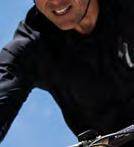


On Thursday, May 12, seven members of the Full Circle Everest Team successfully summited Mount Everest. The success of this team nearly doubled the number of Black climbers who have summited Mount Everest.
Towering 8,850 meters above sea level, Mount Everest is the highest peak above sea level and the most famous mountain in the world. Located on the Nepal-Tibet border, this infamous peak lures hundreds of climbers every year. Over 6,000 people have reached the summit of Mount Everest, and until the recent success of the Full Circle Everest Team only eight of those climbers were Black.
The Full Circle Everest leader, Philip Henderson, shares that, “I am deeply honored to report that seven members of the Full Circle Everest team reached the summit on May 12. While a few members, including myself, did not summit, all members of the climb and Sherpa teams have safely returned to Base Camp where we will celebrate this historic moment!”
The Full Circle Everest team was supported by Sherpa, who played a pivotal role in the success of this historic climb, and the team acknowledges that they would not have been successful without Sherpa.
Learn more at full-circle.asjmag.com
YOSEMITE FACELIFT ANNOUNCES IN-PERSON EVENT AND DATES
The Yosemite Climbing Association (YCA) is proud to announce that in addition to Facelift: Act Local, Yosemite Facelift will be back in-person again this year, September 21-25, 2022. YCA can’t wait to celebrate the history and culture of Yosemite National Park climbing. This will be their 19th gathering to “steward with love” and share the “Yosemite Power”. Join in the largest cleanup of a national park!
Over the past eighteen years, Yosemite Facelift has attracted thousands of volunteers to get involved in the preservation of this national park gem. To date, YCA volunteers have collected over one million pounds of trash from the park. Although the pandemic didn’t allow for an in-person event in 2020 and 2021, Facelift: Act Local inspired volunteers to get out and pick up trash in their local parks and other areas. Over 1,000 virtual volunteers pitched in and brought stewardship into communities across the US and internationally.
This year, YCA and existing groups will be launching Facelift: Act Local events in 10 new locations. Everyone is invited to create a Facelift: Act Local event in parks, open spaces, towns, and cities everywhere. Learn more at facelift-2022.asjmag.com
THE PREMIER BIKE PARK IN THE U.S.




Whether it’s your rst time riding on dirt, or you’re a downhill wizard, the Mammoth Bike Park delivers the ultimate high-alpine riding experience for everyone. With over 80 miles of singletrack, a summit at 11,053 ft and plenty of jumps, berms, and drops to feast on, Mammoth is the country’s biggest and best place to ride.

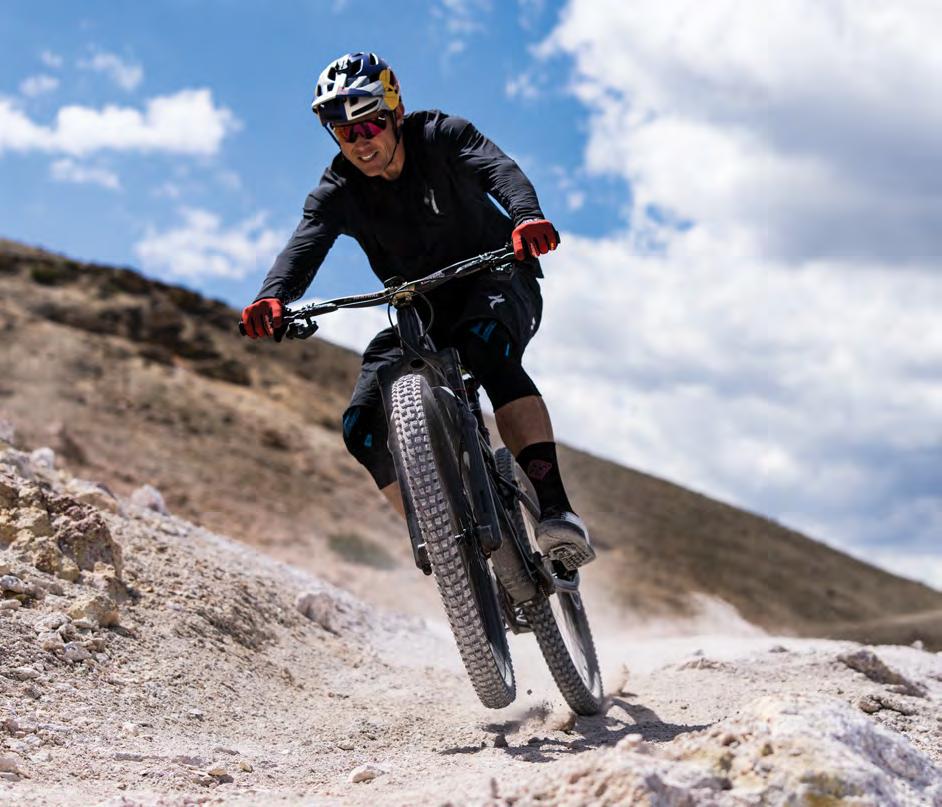
8 ASJ — June/July 2022
DON’T MISS AN ISSUE: Support independent media. Become a member and have Adventure Sports Journal delivered to your door. As low as $5 per month.
FUNDING FOR THE REMEMBRANCE RUN




After receiving funding through a Dreamstarter Award, champion high school runner Kutoven “Ku” Stevens, and his parents Misty and Delmar, will once again be hosting the Remembrance Run this year.
The purpose of the Remembrance Run is to “honor the children who survived Indian boarding schools and to remember those who never came home, by laying down prayers with our feet,” according to the official Facebook page for the event.
Last year the Remembrance Run followed the path of eight-year-old Frank Quinn, Stevens’ great-grandfather, as he escaped from Stewart Indian School in Carson City and ran home to the Yerington Paiute Reservation, over 50 miles away.

This year the Remembrance Run will travel in the reverse direction, from the Yerington Paiute Reservation to the Stewart Indian School in Carson City.
Stevens says, “We are proud of the awareness we created with last year’s run, and now we want to hear about the progress that has been made with the investigations. We are sending invitations to state and federal dignitaries to join us at the conclusion of the run to discuss ongoing investigations and matters of reconciliation.”



Run organizers are asking for participants to bring offerings with them to place at the children’s graves upon completion of the 50mile, two day event. “This is not just about running, it’s about healing,” says Stevens. Learn more at remembrance.asjmag.com
LEGAL ACTIONS CHALLENGE HUGE LOGGING PROJECT


A coalition of environmental, business, and recreational organizations — joined by the County of Ventura and the City of Ojai — filed suit in federal court on April 27 to challenge a commercial logging and vegetation removal project atop Pine Mountain and Reyes Peak in the Los Padres National Forest.
The project area — equivalent in size to 575 American football fields — is located on the ancestral lands of the Chumash. It is historically and culturally important to Indigenous people, popular with locals and tourists for a range of recreational activities, designated critical habitat for the endangered California condor, and home to other sensitive wildlife, rare plants, old-growth conifer forests, and unique ecosystems.
More than one-third of the project area is in a protected roadless area that has never been degraded by commercial logging or other industrial activities. The area is proposed for wilderness protection under the bipartisan Central Coast Heritage Protection Act (HR 2199), now awaiting final approval in the Senate.
“We’re proud to stand with Indigenous leaders, local businesses, conservation and recreation groups, and city and county governments in demanding a more thoughtful environmental review of this harmful project,” said Los Padres ForestWatch executive director Jeff Kuyper. Learn more at los-padres-logging.asjmag.com
CLEAN UP THE LAKE RECOVERS OVER 25K POUNDS OF TRASH
The Clean Up The Lake SCUBA dive team embarked on an extraordinary effort to recover submerged litter around all 72 miles of Lake Tahoe’s shoreline. The project launched on May 14, 2021 and was officially completed on May 10 of this year. In total, the dive team collected 24,797 pieces of litter, bringing the total weight removed to 25,281 pounds.
“Over the past year, despite winter weather, Covid and wildfire related challenges, our dive team has been in the water at every opportunity to complete this unforgettable effort,” said Colin West, founder and executive director of Clean Up The Lake. “While the dive team has removed many expected and unexpected items along the way, ultimately what we hope people remember is the length that one group of individuals was willing to go to in order to protect their home and their planet, and in turn people should ask themselves how they are choosing to contribute to preserving our environment today.”
As divers circumnavigated the lake, they recovered not only plastic bottles, cans and other “typical” litter, but items that included engagement rings, 1980s Nikon film cameras, entire lamp posts, “no littering” signs, massive pieces of broken down boats and engine blocks, lost wallets, cordless home telephones, a Blackberry mobile phone, and more.
Learn more at lake-cleanup.asjmag.com
OUTSIDE MEDIA CEASES PRINT PUBLICATION OF 80% OF THEIR MAGAZINES
Robin Thurston, a tech millionaire and former owner of MapMyFitness, has continued to fulfill his vision of turning his Outside umbrella of brands into the “Amazon Prime of the outdoor media world.”

Trail Runner, Backpacker, Beta, Climbing and more magazines are being shifted online only as Thurston’s parent company Outside Media will cease print publication of 80% of their dozens of magazines.





A representative with Denver based PR firm Ink Communications responded to an inquiry about Trail Runner with a statement boasting of Outside’s acquisitions and “quadrupled paid membership,” adding that “Outside made the difficult but necessary decision to reduce headcount as the publishing industry as a whole moves online.”
It is unclear at this time how many jobs will be lost at Trail Runner and Climbing but layoffs have already begun according to social media reports from former employees.


Thurston and Outside are betting big that the future of outdoor media is apps and phone-based content with consumer data tracking and subscription paywalls. Some within the outdoor publishing landscape are questioning these moves. “Corporate outdoor media is in the process of losing its soul,” said ASJ editor Matt Niswonger in response to the layoffs.
Learn more at outside-shift.asjmag.com

www.adventuresportsjournal.com 9
AGILITY BOULDERS 831.322.4590 1404 38th Ave Capitola, CA Experience the fun and power of bouldering scanme! ➠try our obstacle course
excellent cross training for surfing and mountain biking ➠book an action filled birthday party with us HELP SUPPORT INDEPENDENT MEDIA Adventure Sports Journal is one of the last independent outdoor magazines in the country. We are in direct competition with corporate media and online platforms. ASJ depends on the support of our advertisers and people like you. We Need Your Support We think ASJ is an important voice for the outdoor community in California. Memberships as low as $5 per month and includes a subscription! adventuresportsjournal.com/membership If you agree then consider helping us continue our work by becoming a member.
➠
A CALL FOR HELP
The Amah Mutsun Tribal Band needs support to stop the proposed Sargent Quarry
 By Krista Houghton
By Krista Houghton
Running through the woods, climbing mountains, rafting rivers and surfing waves teach us the spiritual aspects of nature. We need these experiences to fulfill our athletic, spiritual, and cultural potential. We need these experiences to help us truly appreciate our lives. So why on earth would a company suggest building a gravel mine at one of the oldest, and most sacred sites where the Amah Mutsun tribe has celebrated their cultural ceremonies for thousands of years?
The area in question is where the edges of the Santa Cruz, Gabilan, and Diablo Mountain ranges converge, and their watersheds flow into the Pajaro River. It’s a rich, biodiverse area that contains numerous endangered species along with a vital corridor for wildlife to migrate into and out of the Santa Cruz Mountains. The Amah Mutsun Tribal Band call the area Juristac (Huris-tak), and it is where their ancestors held their most vital sacred activities. “This area contains our most important ceremonial site; it is the heart of my Tribe,” states Amah Mutsun Tribal Chairman Valentin Lopez. According to Lopez, the Juristac land once covered over 64,000 acres for the Amah Mutsun Tribe. Since then, it’s been parceled off and the 5,300-acre property, located just south of Gilroy is privately owned by Sargent Ranch LLC, which has applied for permits to build a 403-acre sand and gravel quarry. This proposed mine would include a 14acre processing plant, three open pit

quarry sites, each up to 400 feet deep, a 1.6-mile-long conveyor belt, and numerous 30-foot-wide access roads.
The land is nearly pristine, compared to many irreparably altered cultural sites in the area. “Not only is there ceremonial significance for my Tribe, but the conservation value of the land is also tremendous,” says Lopez. It also contains several natural tar pits where the Amah Mutsun Tribe say their ancestors held their most important ceremonies. “For some of the ceremonies indigenous people would come from as far away as Yosemite,” says Lopez. “They are going to tear down four sacred mountains and turn them into a big pit in the ground, and all just for money.”
The Amah Mutsun Tribal Band, made up of descendants of survivors of the Santa Cruz and San Juan Bautista missions, say they have plenty of proof of the importance of the location, and oral history documentation is recorded in the Smithsonian archives. “The
whole area of Juristac is a power place. This is where our ancestors held healing ceremonies,” states Tribe member Ed Ketchum. Nathan Olivas, 84, Tribe member, recalls going mushroom and turkey hunting in the area in the 1940s, though he didn’t know of the cultural significance at the time. “I didn’t know I was Indian until I was in high school,” says Olivas. Lopez, 70, had a similar childhood; his parents would tell him to say he was Mexican, not Native American, because it was common for Native children to be forcibly removed from their families and be placed in boarding schools operated by the federal government and churches. It was not until 1978 with the passing of the Indian Child Welfare Act that Native American parents gained the legal right to deny their children’s placement in off-reservation schools.
The Tribe currently owns no land within their traditional territory and have no access to the areas inside the Sargent Ranch, currently owned
as private property. Lopez has asked repeatedly to be allowed access but has been denied. An offer for the land has been made at the appraised value, but that also was denied. Ideally, the Tribe would like to buy the land; doing this would allow for the protection of Juristac. It could become a reserve stewarded by indigenous people and be a celebrated ceremonial and educational center, allowing for visitors, and a renewed growth of their culture. “Restoring ceremony and sacredness to the Land is our most important goal,” Lopez explains.
The gravel mine would displace 9.7 million cubic yards of topsoil and other materials for the project, over a 30-year term and employ a mere 15-20 people.
“The mine will destroy the land forever; you cannot mitigate that kind of destruction on a sacred site,” says Greg Cotten, Marine Biologist, and longtime advocate for the Tribe.
10 ASJ — June/July 2022
“When we broke our relationship with the indigenous people, we also broke our relationship with nature. Until we heal that wound, we will never heal our relationship with nature.”
“When we broke our relationship with the indigenous people, we also broke our relationship with nature. Until we heal that wound, we will never heal our relationship with nature,” says Cotten. The cities of Santa Clara, Santa Cruz, Watsonville, and Morgan Hill have already announced opposition to the project, as well as several religious, political, and academic groups. Most oppose it for human rights reasons, but also the proposed site is known habitat for steelhead trout, California red legged frog, and tiger salamander, all federally protected species. “That we’re even having to fight this thing or even talk about this is so troubling,” says Lopez.

The Environmental Impact Report (EIR) is due out in June, and the public
ULTIMATE ADVENTURE

comment period is open for 60 days after that. Lopez states, “We’ve been told the only way to stop the permit is by overwhelming public support. By signing the petition and providing public comment, your support will help protect Juristac. This is sacred cultural land, but also has massive environmental importance, it’s a double headed spear that we need to preserve.”


The Amah Mutsun Tribal Band is also planning a rally after the EIR is released. Lopez invites all to come and “stand with the Native people and stand with the environment.” Please stop the mine, sign the petition, and make your voices heard. We all should have access to the places we love to practice our own sacred activities.
Please help save Juristac. Get information and learn more at ProtectJuristac.org. Scan the QR code to sign the petition.


www.adventuresportsjournal.com 11
Trail Open May 27–September 18 Reserve Your Seat at RideTheHiawatha.com and find lodging information. 208.744.1234 I-90 EXIT 0 AT THE ID/MT LINE. CHECK “MOST AMAZING RIDE” OFF YOUR BUCKET LIST. 7 SKY-HIGH TRESTLES . 10 AMAZING TUNNELS . 15 DOWNHILL MILES. 1 AMAZING STORY TO TELL. 3
Opposite page, top to bottom: Sargent Valley at Juristac, the location of proposed mining pits (Alexii Sigona); Amah Mutsun tribal members and supporters gather in support of a resolution to protect Juristac in Morgan Hill, January 2020 (Alexii Sigona). This page, top to bottom: Amah Mutsun tribal youth pause for a photograph during their 5-mile Amah Mutsun Youth Walk for Juristac in October of 2020 (Tyler Kendrick); Amah Mutsun tribal members gather earlier this year on a ridge overlooking a portion of the Juristac tribal cultural landscape in southeast Santa Clara County (Alexii Sigona).
ROUTE TO THE RIDE THE HIAWATHA TRAIL
— Greg Cotten, Marine Biologist
MORE THAN MOUNT WHITNEY
Inyo County offers moderate majesty for adventurous hikers
Words & photos by Matt Johanson
What dramatic extremes fill Inyo County. The large rural community on California’s eastern border boasts the tallest mountain in the lower 48 states, the lowest and hottest points in North America, and the oldest trees in the world. Mount Whitney, Death Valley and the Ancient Bristlecone Pines Forest all deserve attention.
Yet one need not climb high mountains, trek through arid desert or even venture far off Highway 395 to discover rewarding and accessible adventures. Consider the following outings on public land of Inyo National Forest or Bureau of Land Management, all easily reached in summer and fall, and free to visit.
FOSSIL FALLS

A short walk leads to a fascinating area of sculpted rock. Owens River, which flowed at far greater volume during the last ice age than it does today, carved volcanic basalt into smooth and interesting shapes. How different this area must have been during the Pleistocene Period when volcanoes erupted often and giant lakes filled this now-dry valley.
Look for a Fossil Falls sign on Highway 395 north, about 40 miles south of Lone Pine, and follow a dirt road to a parking area with picnic tables and an outhouse. Fossil Falls is just a quarter-mile walk away on a marked trail.
ALABAMA HILLS
Wind erosion created the curiously shaped arches and formations of granite in this nearly 30,000-acre area between the highest Sierra Nevada peak and the
Owens Valley. Hikers, climbers and photographers enjoy exploring the landscape of which 18,610 acres became a National Scenic Area in 2019.
Civil War-era miners sympathetic to the South named the hills for a Confederate battleship. An effort to rename the area began in 2020, but the government hasn’t done so yet.
Multiple short hikes lead through the Alabama Hills. If you only do one, make it the 1.5-mile Mobius Arch Loop Trail, which leads to the photogenic Mobius Arch. The “money shot” looks west through the arch at dawn to capture morning light on Lone Pine Peak and Mount Whitney.

From Lone Pine, take Whitney Portal Road west for 2.7 miles and turn right onto Movie Road.

HAPPY BOULDERS
These stones live up to their name. House-sized boulders consisting of volcanic tuff rock have tumbled into narrow canyons, creating happy hiking and climbing for visitors. If you’re more of a hiker, you can still scramble low on the rocks for fun, carefully. The trail extends about a mile to the canyon’s end.
From Bishop, drive north on Highway 395 and turn onto northbound Highway 6 for 1.5 miles. Turn left on
Five Bridges Road for 2.4 miles and then turn left onto unpaved Chalk Bluff Road for 2.3 miles to the parking area. The trail to the boulders leads to the north.
BUTTERMILK BOULDERS
Named for the dairy farming that was once common here, Buttermilk Boulders consists of massive glacial boulders (consisting of quartz monzonite and closer in size to mansions than houses) in close proximity
12 ASJ — June/July 2022
This page, top to bottom: The spectacular southern Sierra, including Mt. Whitney as viewed from the east; Indigenous people of Inyo County call the area Payahuunadü, which means “Land of the Flowing Water.” Opposite page, left to right: Mobius Arch frames its granite neighbors in the Alabama Hills; The author, Matt Johanson, bouldering in the Happy Boulders area.
to Mount Tom and neighboring High Sierra peaks. Some 500 bouldering problems attract climbers from around the world, but you don’t have to be a climber to walk around and appreciate the unique and inspiring scenery. Multiple trails lead through the area so pick one and explore.

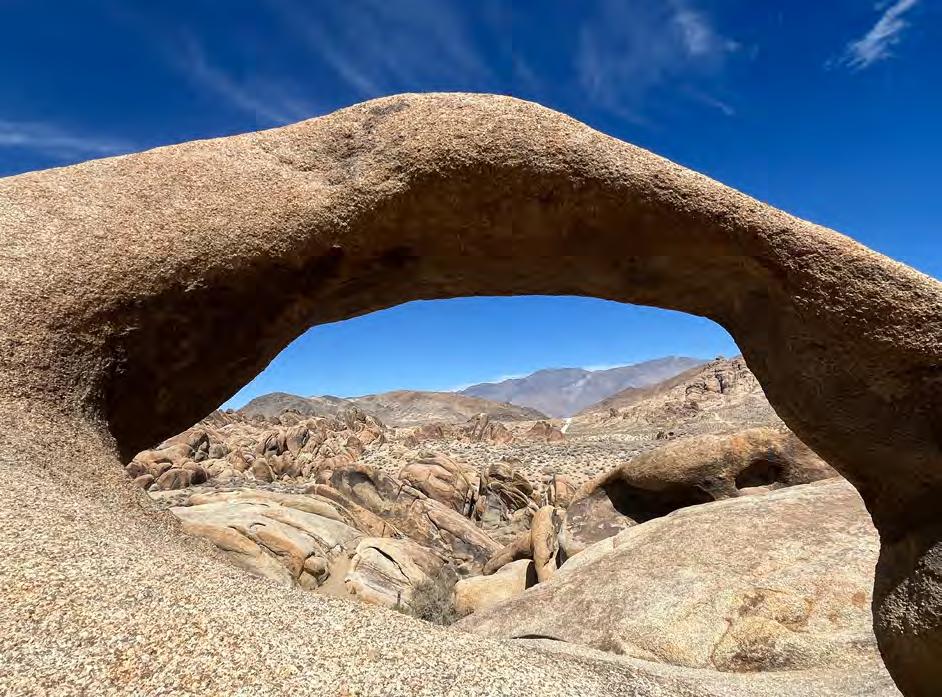
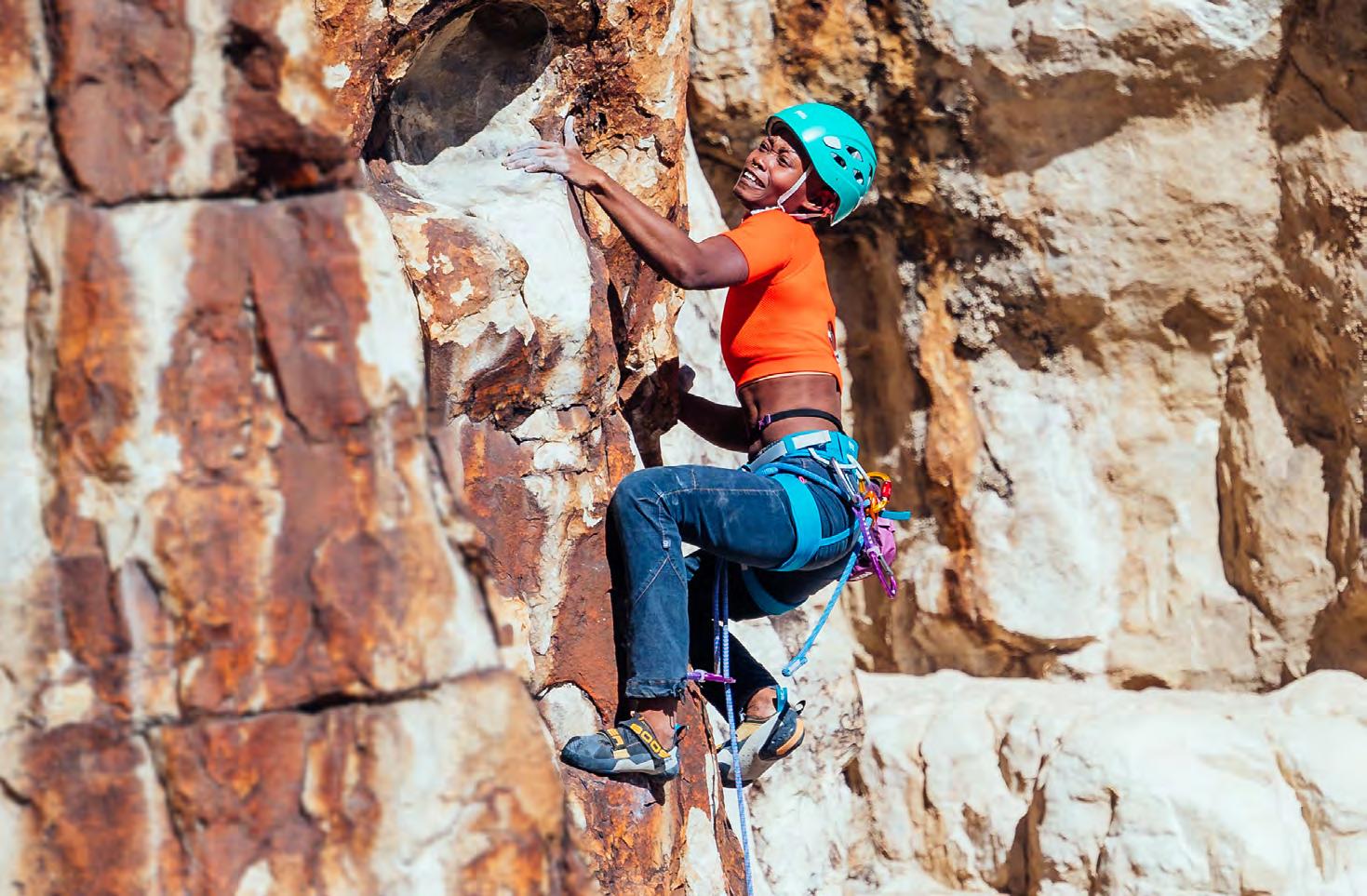
From Bishop, take Highway 168 west to Buttermilk Road, turn right and drive 3.4 miles on a dirt road to a parking area.

HORSESHOE MEADOW
If you’ve come this close to the High Sierra, you really should try some high-elevation outings. A four-mile loop leads around scenic Horseshoe Meadow, by streaming creeks and past foxtail pines. Swimming in the creeks are small and beautiful fish which inspired the name of this Golden Trout Wilderness. Those rare foxtails grow only in the Southern Sierra and can live
more than 2,000 years. Save this one for after you’ve acclimatized a while because the trail, while fairly flat, stands around 10,000 feet above sea level.
To make a loop, connect the Cottonwood Pass, Trail Pass and Mulkey Pass trails.

From Lone Pine, turn west onto Whitney Portal Road. After three miles, turn left onto Horseshoe Meadow Road. Drive about 20 steep, curvy and adventurous miles to the road’s end at Horseshoe Meadow trailhead.
TREASURE LAKES
A half-day outing leads to dreamy alpine lakes beside a striking mountain which may inspire climbers. From South Lake, take the Bishop Pass Trail to the south and turn right toward Treasure Lakes at the junction. Our route meanders westward before turning south and climbing to the lakes. A round trip involves about six miles between 9,800 feet and 10,700 feet.
www.adventuresportsjournal.com 13
TOP AND SIDE PROTECTION in our helmets. Various construction methods of our harnesses. Longevity of our carabiners.
Half Page running_Adventure Sports Journal.indd 2 5/11/22 10:33 AM
THESE ARE THE PETZL DIFFERENCES WORTH JUSTIFYING. © 2022 - Petzl Distribution - JEREMIAH WATT
Treasure Lakes offer good swimming and fishing. Neighboring Hurd Peak, a strenuous class 3 climb, was named for engineer H.C. Hurd who made the first known ascent in 1906.
From Bishop, drive southwest on Highway 168 for about 15 miles. Then turn left onto South Lake Road and drive another six miles to South Lake. Park in the day use area.

ONION VALLEY, KEARSARGE PASS AREA
If you’re annoyed that the Alabama Hills are named for a Confederate battleship, here’s a good remedy: visit the Kearsarge Pass area, named for the Union ship which sank the Alabama in 1864. A five-mile round trip trek takes hikers to Little Pothole, Gilbert and Flower lakes, which offer good swimming and fishing.

Ambitious hikers can continue to Kearsarge Pass which delivers broad and grand views of Kings Canyon National Park. That extends the trip to nine miles round trip.

From Independence, drive west on Onion Valley Road for 13 miles to a large parking area. Kearsarge Pass trailhead stands at 9,200 feet, the lakes at about 10,500 feet and Kearsarge Pass at




Top to bottom: Visitors to Kearsarge Pass earn this rewarding view of Kings Canyon National Park; Buttermilk Boulders and Mount Tom combine for a memorable landscape.
11,700 feet, so take your time and take it easy.





In these parts, white settlers’ removal of the Paiute and other tribes to distant reservations was the main event of the 19th century. Los Angeles’ securing rights to water and building an aqueduct to deliver it to Southern California transformed the 20th century. Signs of both conflicts remain in the 21st century, as the Paiute regrouped on a reservation in Bishop and Los Angeles Department of Water and Power signs mark the landscape throughout the region.


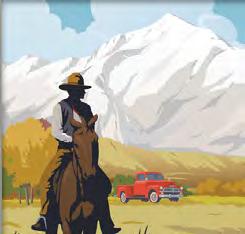
The name Inyo comes from a Paiute word meaning “dwelling place of the Great Spirit,” but one need not be Indigenous to feel spiritually moved by the grand scenery. These warm-ups may inspire you to return for more ambitious outings, like the Ancient Bristlecone Pines Forest, Death Valley and Mount Whitney. Inyo County deserves your time.

14 ASJ — June/July 2022
EARN YOUR BEER

Kayaking San Diego’s Mission Bay

 By James Murren
By James Murren
THE EARNING









 By James Murren
By James Murren

The setting sun warmed our backsides as a steady tailwind helped us across San Diego’s Mission Bay in the direction of Vacation Isle. The tide was working against us on the open water crossing. My wife and I were in kayaks on a moonlight paddle with a group that set out from the Mission Bay Aquatic Center, which is jointly owned and operated by Associated Students of San Diego State University and UC San Diego Recreation. Looking east, the big ole moon rose over the AnzaBorrego desert and the mountains of Laguna and Cuyamaca. Sitting in our boats in the bay, watching several brown pelicans, I experienced an understanding of home.
We circumnavigated the Isle by going clockwise, rounding it and then working our way back across the bay. Small lights shined from the sterns of the kayaks — tethered beacons for







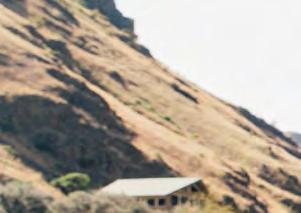


others to see. The breeze calmed and silence fell over the water in the final minutes of day’s light. Suddenly, the sky, that was softly lit up by a nearly full moon, exploded into greens and reds and golds: nearby Sea World was having a fireworks show. Still in the boats, we turned them around to see the display and paddled backwards, oars dipping and boats sliding while we ooooh-ed and aaaah-ed.
THE BEER



Best Day Brewing is a new nonalcoholic beer crafter out of northern California. They make a Kolsch, a Hazy IPA, and a West Coast IPA. On the paddle outing, I had the West Coast IPA. Refreshing? Yes. Taste like an IPA? Indeed. Citrusy and all that good stuff? Yep. Hydration? Surely! bestdaybrewing.com

The next morning, I got in my regular Saturday morning ride: 25+ miles in the Cuyamacas this time around. Pedaling a mountain bike up and down the desert-to-mountains landscape on a warm spring morning had me hankering for a post-ride beer. The new Rove Beer hit the spot. If there’s a brewery trying to do everything right when it comes to sustainability, Pure Project is easily in the top of any list anywhere. Rove comes in at 4.2% and goes down easy, pretty much perfect for a trailside beer, or at the crag, the river, the mountain top, the beach. As the Pure people say, it’s an adventure beer (American style lager), plain and simple. rove.beer

www.adventuresportsjournal.com 15
Looking east, the big ole moon rose over the Anza-Borrego desert and the mountains of Laguna and Cuyamaca. Sitting in our boats in the bay, watching several brown pelicans, I experienced an understanding of home.
cool & dry all summer long in Recover Sport. 100% Recycled, Sustainable Apparel. RecoverBrands.com
Stay
THE PACKRAFT FACTOR
How collapsible boats are changing backcountry exploration
By Anthea Raymond
What can weigh less than seven pounds, fit into your pack, and take you places you never dreamed possible? For more and more of us, it’s a packraft: a light, durable, inflatable boat that goes pretty much anywhere.

Some packrafts are designed for high adventure, multi-day experiences combining backpacking and stout whitewater like a Class V section of the Middle Fork of the Kings River (aka Middle Kings) or the headwaters of the Kern. Others work great for floating or fishing on a remote lake in the Sierra such as Crowley. Mountain bikers use them to drift their bikes down waterways. Packrafts have even been used on California coasts, especially where tide changes leave paddlers high and dry. And, of course, they make for family fun on a nearby reservoir or sheltered bay. The modern packraft movement started in Alaska, where water complicates almost every adventure. The super-light packraft was a solution. A decade ago, the center shifted to the Rockies and Wyoming. Now, interest and activity is everywhere. California is more complicated than some places, with snow and rain creating mostly spring and summer options. Packrafters point to the “freedom, solitude, and joy” found in reaching pristine places. But new packrafters tend to progress too rapidly and don’t always
understand the risks, says Luc Mehl, the author of The Packraft Handbook, the bible of this quickly growing sport. “You can be a phenomenal hunter, backpacker or mountaineer. But water is a game changer,” he adds.

CREATING A CULTURE OF SAFETY
Mehl only learned to swim in college. He too first explored the outdoors as a backpacker and skier. But when he saw how packrafts extended his reach, he was hooked. Then, in 2014, he lost a close friend on the water. He committed himself to creating a culture of safety around the sometimes too-accessible sport, eventually becoming a swiftwater rescue instructor.
“What is also often missing for backpackers-turnedpaddlers,” says Mehl, “is boat control. When I first started, I paddled like a hiker, and bombed straight down the river. I had to learn how a river works,” to use eddies and other features to navigate. Learning to rescue yourself and others is also key. Mehl’s book has a detailed chart for assessing your skill level
and communicating that to others. “People get into trouble by choosing the wrong destinations for their skill level and equipment,” he says.
GEARING UP
A raft and related gear should add between ten and 15 pounds to your pack, with your boat a big part of that. The two leading packraft manufacturers are Kokopelli and Alpacka Rafts. They offer many models, suitable for many goals. Other inflatable kayak companies, like Advanced Elements, have also added packrafts to their product line. Most weigh from five to ten pounds
16 ASJ — June/July 2022
and are made of durable nylon. They can be outfitted with a range of features including thigh straps, selfbailers, spray decks, and built-in gear storage. Some are installed at a buyer’s request, some are removable to adapt to conditions. They also generally come with an air pump, a soft bag that pushes air into the boat, and a repair kit.

Packrafters also need a lightweight paddle,

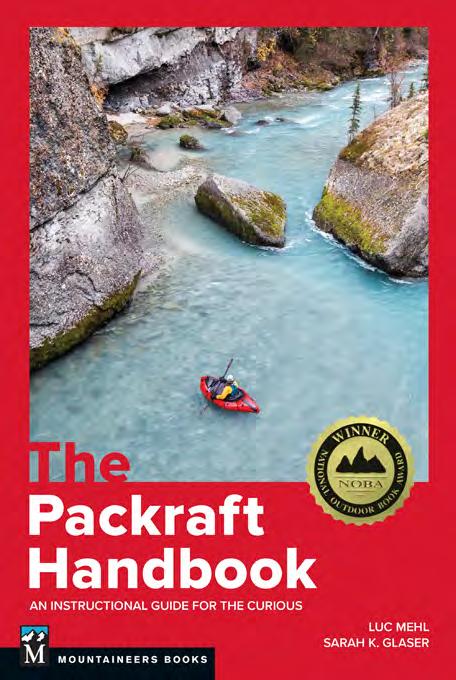
preferably one that you can “break down” to fit in your pack. Aqua Bound has a light four-piece model as does Kokopelli. By law, you must also wear a personal flotation device (PFD), a life vest with flotation to keep you safe in moving water. NRS makes a good basic vest, with Astral and Stohlquist offering more deluxe models. Your vest should fit snugly, so it doesn’t cover your face when you float.
On a lake or other flatwater, you may not need a helmet. But even in Class I moving water, consider it essential. NRS again has a variety of reasonably priced models. For most settings, you will also want paddling or approach shoes that drain and dry quickly, as well as clothes that keep you warm and dry in your boat. Depending on water temperatures that might mean a wetsuit or drysuit even in summer. Water

www.adventuresportsjournal.com 17
Opposite page, top to bottom: Paddlers enjoying a flat section of the North Fork of the Smith River (Robin Levick); Personal flotation devices (PFDs) are required by law and keep you safe in moving water (Gareth Tate/Astral). This page, left to right: The Packraft Handbook from Mountaineers Books — essential reading for aspiring packrafters; Packrafters getting through a shallow river section in Alaska (Luk Mehl).
from freshly-melted snow can be quite dangerous, no matter what the outdoor temperature.

TAKE YOUR TIME


There’s also much to be learned about paddling, packing, planning, risk assessment, and rescue. And experts agree: it shouldn’t be learned on the fly — and certainly not on a multiday adventure. They say Mehl’s book is a great tool, with its foundational chapters for the beginner and more advanced sections on rivers, rescue, trip planning emergencies, packing, and more.
Joseph Bell of the American Packrafting Association (APA), an education and advocacy group for packrafters, advises finding mentors and taking a class if you can. In California, Melissa DeMarie’s California Watersport Collective has offered packrafting courses for several years as well as private lessons. Consider also swiftwater training — Sierra Rescue is the go-to — even if it is not specific to packrafting. An introduction to whitewater kayaking class will also teach you relevant skills, including water reading, risk assessment, and trip planning. Robin Levick, a California packrafter, says classes are also a great way to meet people in the wider paddling community.
Levick is also active on the California Packrafting Facebook page, where local packrafters share tips about gear and trips. The group also hosts live events, like its Fourth Annual California Packraft Soirée, on the South Fork of the American River August 19-21, 2022. The APA also has a forum where you can find trip reports and other info related to California.
Mehl and others mentioned here have also helped develop the new packrafting curriculum that the American Canoe Association (ACA), the nation’s oldest paddling organization, is launching. Students can progress through flatwater, and Class I and II whitewater.










The ACA has already started certifying its first wave of instructors. Some work in California, so look for more classes soon.


In the meantime, to get going safely, be solid in flatwater with strokes, river knowledge, gear assembly, and selfrescues. “Go to a local waterway and practice, practice, practice,” says Mehl. “Be sure you can get back into your boat.” Sheltered bays like the Naples canals in Long Beach or the shore along Catalina Island are great jumping off spots. Then, take baby steps, perhaps on Class I runs you find on the Dreamflows, California Creeks, or American Whitewater websites.
A popular run at this level is Redwood Creek in the Redwood National Park. (Just pick the right season, in summer, pontoon bridges block sections.) The APA’s Bell, who lives in California, says the trip showcases what is special about packrafting: a hike to an otherwise unreachable put-in, amazing scenery, and a finish at the ocean and your car — all in one day. Note: you’ll need a shuttle driver for this one, though many packraft trips make loops, with a pack in and a paddle out. Others suggest the Owens River in Central California for a similar experience.
Levick also puts parts of Cache and Butte creeks, and even sections of the Sacramento, Yuba, Russian, and Mokelumne rivers, on the list. He recommends calling outfitters running those sections for advice. He also says gentle tidal estuaries and river mouths can sometimes be good places for beginners to experiment with moving water. And, he adds, “Read Luc Mehl’s book. It should really come with every packraft sold.”
The Packraft Handbook by Luc Mehl, is published by Mountaineers Books — an independent non-profit publisher based in Seattle, WA with over 60 years of publishing, 800 titles and award-winning publications. Learn more at mountaineers.org

18 ASJ — June/July 2022 BlueWaterVentures.org • 831.459.8548
Bioluminescence & Full Moon Kayaking Trips, Whales & Wildlife Coastal California, Baja, Belize, Tonga and Beyond
+
Train Hard / Be Safe • SierraRescue.com • 800-208-2723
Expert instruction in the outdoor rescue industry.
Make sure to take your time to learn the skills necessary to get into packrafting. Pictured here is a paddler bracing to stay upright on the Kings River in Alaska (Luc Mehl).
all rush no routine.
Life—like water—suffers in stagnation.










































Break out of the daily grind on a Middle Fork American River rafting trip with OARS.
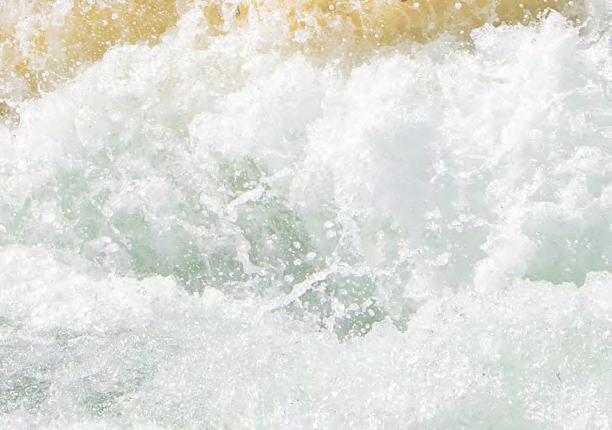


No mind-numbing chores, no screaming deadlines, no boring meetings.

Just you, some friends, a ridiculously fun river and a super-pro guide to keep y’all pointed downstream.

Are you up for the rush?

online & save 10% oars.com
book
THE SANCTUARY
30 years of protecting the Monterey Bay National Marine Sanctuary
 By Leonie Sherman
By Leonie Sherman
Four thousand feet below the ocean’s surface, 75 miles offshore, the summit of the 28-mile long Davidson Seamount, an underwater volcano, rises 7,500 feet from the seafloor. The 2018 discovery of an octopus garden near its base electrified the scientific community. “We were in the last hour of a 32-hour dive with a remotely operated vehicle, when we came across a group of around 25 octopuses,” explains National Oceanic and Atmospheric Administration (NOAA) Ecologist Chad King. “At first, we didn’t know what it was; it looked like flowers or anemones. As we got closer, we recognized these octopus are in this peculiar position, essentially, upside down showing us their bellies and stomachs.”
About 10,000 of these normally solitary deep sea critters were brooding their eggs, clustered around a warm water seep, “like ants on a trail of honey,” according to King. This was the largest octopus gathering documented on the planet, and the first seafloor warm water seep identified off the California coast. When researchers returned, they became the first humans to watch baby deep sea octopuses hatch. They discovered another octopus garden harboring 3,600 pale purple expectant mothers six miles away at the base of a smaller volcanic knob. And they found a fresh whale carcass, with the heart intact; samples revealed a new kind of boneeating worm.

DESIGNATION AS A SANCTUARY
None of this would have been possible without designation of the Monterey Bay National Marine Sanctuary
(MBNMS), which celebrates 30 years this autumn. It extends from the shore to the bottom of a canyon over 11,800 feet below the sea, protecting an astounding range of habitats and creatures. “The Monterey Canyon rivals the Grand Canyon and Yosemite,” enthuses Ginaia Kelly, the Chapter Director of the Monterey Bay National Marine Sanctuary Foundation. “It’s known as the Serengeti of the sea.” Covering almost 300 miles of rocky shoreline, from Marin to San Luis Obispo counties, the sanctuary extends about 30 miles offshore, and includes the Davidson Seamount further offshore. Designated by an act of Congress in 1992, it protects astounding biodiversity: three dozen species of marine mammals, 94 species of seabirds, and over 500 species of fish, along with a wonderland of Dr. Seuss-worthy ten-foot tall corals and sea sponges still being categorized.
Tasked with cultural preservation as well, the sanctuary protects 1,276 shipwrecks and 718 prehistoric sites. At 6,094 square miles, the MBNMS is larger than Connecticut and Rhode Island put together, and 800 square miles bigger than the largest national park in the lower 48. Within its boundaries, offshore oil drilling and dumping are prohibited, a special permit is required for any activity that disturbs the seafloor or cultural and marine resources and artifacts, and water quality is carefully monitored.
“There could be other new things down there, things we don’t even know about yet,” explains NOAA Education and Outreach Coordinator Amity Wood. “We may not know exactly what is there, but we know we need to learn more about these biologically significant areas. Something can be worth protecting even when we don’t understand it fully.”
Because if we don’t protect it, we trash it. “There is evidence of humans down there at 12,000 feet, in these incredible places we have never been to and don’t know anything about … we’ve already littered there!” exclaims Wood. “All of our discarded trash flows to the ocean. There is no part of the ocean untouched by humans.”
Marine sanctuaries aim to manage ocean resources. Contrary to popular misconception, commercial and recreational fishing are subject to
20 ASJ — June/July 2022
the exact same regulations within a national marine sanctuary as outside of its borders. Recreational activities like kayaking, surfing, snorkeling and diving are permitted.


ADVOCATING FOR PROTECTION

Efforts to preserve the MBNMS began locally, but gained momentum thousands of miles away. Former Secretary of Defense Leon Panetta, now Chairman of the Panetta Institute for Public Policy, was first elected to Congress in 1976, and held several government positions until his retirement in 2013. Born and raised in Monterey, he went to DC with the mission to protect his home.
“The Monterey Bay is such a treasure for those of us who live on the Central Coast. But it’s more than just a pretty stretch of coastline,” Panetta says. “Fifty percent of Americans live near the coast. Climate change is raising sea levels and changing currents which impacts weather systems worldwide. The bottom line is oceans are so much more than recreation, or the beauty we enjoy, or the resources we rely on. Our very health, life itself, is dependent on our ability to protect our ocean.”

When then-President Reagan’s Secretary of the Interior, James Watt, signaled his enthusiasm for offshore
oil exploration, Panetta secured a moratorium on any funding that would advance offshore drilling. “It was an amendment to an appropriations bill,” explains Panetta. “We faced opposition from oil companies and states that depend on oil revenues. But we were able to pull together a delegation of coastal communities and pass that moratorium every year for almost twenty years.”
“But we had to pass it every year,” Panetta says with a sigh. “I worried that if oil prices spiked there would be tremendous pressure to allow offshore oil drilling. So I looked for more permanent protection. At the time most sanctuaries were put in place administratively, but I said to hell with it, I’m going to put in a bill to establish the Monterey Bay National Marine Sanctuary.”
Panetta attached his proposal to a Continuing Resolution, or CR, which keeps the government running when there’s a stalemate over an appropriations bill. “We knew that Bush wouldn’t veto the CR, because it would cut off funding for the federal government,” Panetta explains. Over four thousand citizens attended public meetings or wrote letters advocating for protection. Extensive ecosystembased data secured the sanctuary.
Opposite page, top to bottom: The 2018 discovery of an octopus garden 4,000 feet below the ocean’s surface electrified the scientific community (NOAA/OET); Then- Monterey County Supervisor Sam Farr at a Save Our Shores rally against offshore oil at the O’Neill building, circa 1977 (Save Our Shores). This page, top to bottom: Southern sea otter grooming in the calm waters of Elkhorn Slough, California (Steve Lonhart); Killer whales can be spotted in MBNMS as they make their journey north during the months of April, May and June (Kathryn Hoffman); A gray whale and her calf seek shelter in the kelp forest (Douglas Croft).
www.adventuresportsjournal.com 21
“The bottom line is oceans are so much more than recreation, or the beauty we enjoy, or the resources we rely on. Our very health, life itself, is dependent on our ability to protect our ocean.”
— Secretary Leon Panetta
CITIZEN ACTION

“Citizens have been fighting to protect this coastline for decades, crescendoing with opposition to a nuclear power plant at Davenport landing, a deep water port for an oil refinery at Moss Landing and repeated federal proposals for offshore oil development,” explains Dan Haifley, former director of the O’Neill Sea

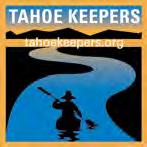

Odyssey and Save Our Shores. “Citizen action on all of those fronts developed a sophisticated active base of people who were concerned about the coast and our ocean.”
Some of that concern was driven by the Santa Barbara oil spill of 1969 which catalyzed the environmental movement; just over a year later the nation celebrated its first Earth



22 ASJ — June/July 2022 TahoeKeepers.org • 888-824-6267 Paddlers: Become a Tahoe Keeper and learn how to self-inspect your boat or board for aquatic invasive species. Lake Tahoe is a national treasure. Help protect it. 3 steps closer to fun CLEAN DRAIN DRY
This page, left to right: A humpback whale breaching off of the Monterey Coast (Douglas Croft); Brown sea nettles occasionally swarm divers as currents push them in towards shore (Chad King). Opposite page, top to bottom: A beautiful nudibranch, Hermissenda crassicornis, makes its way through a tidepool in Monterey Bay (Kameron Strickland); Jack O’Neill in the middle with Dan Haifley and Pete Scrivani of Save Our Shores in front of the SOS office circa 1991 (Save Our Shores).
Day. In 1972, Congress passed the Marine Mammal Protection Act, the Federal Water Pollution Control Act, (overriding then-President Nixon’s veto) and created the Marine Sanctuary Program. Three years later, in 1975, then-President Ford approved the first National Marine Sanctuary — a onesquare-mile area around the shipwreck of the USS Monitor, a Civil War era Union Navy “ironclad” ship.


Specific regulations differ, but all marine sanctuaries share common goals. “The three parts of the sanctuary mission are resource protection, research, and education and outreach,” explains Haifley. These three branches amplify each other, creating a positive feedback loop. Resource protection allows for research, which informs outreach and education. When the public understands the diversity and importance of the sanctuary, they support and fight for more protection.


And we are winning. From humble beginnings protecting a single square mile, the federal government now manages 620,000 square miles of ocean and Great Lakes waters across 15 sanctuaries and two national marine monuments. The system stretches from Washington State to Florida, from Hawaii to American Samoa.
On land lodging encroaches at the edges of popular parks, traffic disturbs wildlife and demand for visitor infrastructure eats away at the center. Without these terrestrial pressures, marine sanctuaries can grow. In 2008, after a seven-year process, 775 square miles of ocean were added to MBNMS


to protect “an oasis of the deep” — Davidson Seamount. In 2014 Congress expanded Thunder Bay National Marine Monument by an astounding 960%, from 448 square miles to 4,300 square miles, thanks to strong public support. And in 2015, they expanded Greater Farallones NMS by over 1,000 square miles and more than doubled Cordell Bank NMS.
ACTIVE MANAGEMENT



“Creating the sanctuaries became the foundation upon which many critical ocean protection laws and policies were enacted,” explains Fred Keeley, Former Speaker pro Tempore of the California Assembly. “An example would be the Marine Life Management Act and the Marine Life Protection Act (MLPA), which I authored in legislature in the late 1990s and early 2000s.”
California made history when they passed the MLPA, changing the entire orientation of the California Department of Fish and Wildlife. “The refrain of that era was ‘we no longer live in a world of abundance, we live in a world of scarcity,’” says Keeley. “We needed to change the regime of the Department of Fish and Wildlife from issuing hunting and fishing licenses to active management.”
The Golden State now protects 16% of its state waters in a network of 124 marine protected areas, with various levels of restrictions. Fishing is banned entirely in critical breeding grounds, which allows populations to rebound. As the fishing around those areas improves, fisherfolk who were
www.adventuresportsjournal.com 23 MONTEREY BAY’S EXCLUSIVE HOBIE DEALER SANTA CRUZ — 831.479.1121 MOSS LANDING — 831.724.5692 KAYAKCONNECTION.COM
“Citizens have been fighting to protect this coastline for decades ... (and) developed a sophisticated active base of people who were concerned about the coast and our ocean.”
SAILOYC.COM (831)818-3645 SAIL ABOARD THE NEW LUXURY 65 ’ TEAM O’NEILL CATAMARAN! OYC’s captains are licensed and insured, and the Team O’Neill is inspected annually by the U.S. Coast Guard. Full Schedule & Tickets Available Online Now! Afternoon & Sunset Sails Local Wine & Beer Tastings Wed. Night Regatta Sails Seasonal Fireworks Sails PRIVATE CHARTERS AVAILABLE FOR SPECIAL OCCASIONS! ASJ_4.656x6.125_05.12.22-2.indd 1 5/20/22 9:56 AM
— Dan Haifley
originally opposed to conservation come to recognize the economic benefits of guarding resources for future generations.
“I doubt that any of that would have been politically possible without the hard work of thousands of organized citizens and people like Leon Panetta and Dan Haifley, from the halls of Congress to the sands of beaches up and down California,” Keeley declares. “We love what we know, and we protect what we love. So for me, right now, the greatest value of the sanctuary is the educational component,” he continues. “Because we know the following two statements are true: California is getting younger and browner every day. The more Latinx students I see learning about our coast and ocean the better I feel about our future. The next generation of ocean stewards will include a large segment of the Latinx community.”
PROTECTING INDIGENOUS CULTURAL VALUES

The next generation of California’s ocean stewards may also include indigenous people who managed the oceans sustainably for 20,000 years before anyone considered the idea of a National Marine Sanctuary. In 2014, NOAA invited communities across the country to nominate their most treasured places for sanctuary status. In July of 2015, the Northern Chumash Tribal Council (NCTC), with enormous community support, nominated 7,000 square miles for sanctuary status.
The proposed Chumash Heritage National Marine Sanctuary (CHNMS) would extend from northern San Luis Obispo County to Point Conception, connecting the MBNMS and the Channel Islands NMS. The proposed CHNMS would protect indigenous cultural values, along with marine habitat and resources. The scoping process, which concluded January 31, 2022 gathered over 30,000 public comments; analysis by the NCTC found over 98% of the comments were in favor of designating the new sanctuary. NOAA will review the public comments and come up with a draft designation document by November of 2022. Another public comment


period will follow, and NOAA aims to finalize sanctuary designation by the end of 2023.
“We bring something to the table nobody else can,” explains Violet Sage Walker, NCTC Chairwoman and the nominator for the proposed CHNMS. “We talk about spirit and how the ocean is the most important thing to people’s spiritual health. It’s not just about biodiversity, it’s about our soul, our happiness, our healing, our ancestors. That is what made our designation stand out among all the other ones.”
Walker is carrying on work begun by her father, the late Fred Collins, over 40 years ago. “This work is not something we can take a break from,” explains Walker. “We don’t clock out after 40 hours. We are obligated to do this until designation is secured, and then we are obligated to co-manage.”

Because Walker is not just working for her father, or her ancestors, she is working to preserve her people’s way of life. “Look at what is going on in Ukraine, all these people are outnumbered, outgunned, but they are protecting their homeland.” She takes a long breath and releases it slowly. “We are protecting our homeland, we are fighting for our way of life. So we have more skin in the game than anybody.”
Despite the challenges, Walker is hopeful about designation. “There is no reason not to designate the marine sanctuary, there are no drawbacks,” she explains. “There are no ‘competing interests’, we all have the same interests: to prolong our quality of life on this planet. If something is harmful to fishing it’s harmful to the sanctuary as well. Nobody who uses the land or the ocean should be opposed to this designation.”
Everybody who cares about the ocean can contribute to protection efforts and the proposed CHNMS. “Aside from just supporting the sanctuary through letters to NOAA, the most important thing is to stay engaged,” explains Walker. “Elect officials who support work on climate change, conservation, water protection. During the Trump Administration we were dead in the water. The voice and support of your elected officials matters.”
24 ASJ — June/July 2022
831.454.9254 104 Bronson St. #12 Santa Cruz go online or come by to check out this fantastic gym Yoga drop-ins welcome Climbing Weight Room Cardio Deck www.pacificedgeclimbinggym.com more than just a climbing gym
A leather star clings to a rocky pinnacle within a kelp forest, where all the rocks are covered with colorful algae or bright invertebrates, like the orange tunicate (Chad King).


get Ready for on the North SummerCoast!Fun Check out our activities calendar for the latest family-friendly activities, live music, and events happening all Summer long at Costanoa! RESERVATIONS 877-262-7848 | COSTANOA.COM 2001 ROSSI RD. AT HWY 1 (30 MIN. NORTH OF SANTA CRUZ)
SHECHANGE
Telling the story of women’s big wave surfing
Story by Krista Houghton • Photos by Sachi Cunningham
SheChange is an intimate journey with four of the best women big wave surfers: Paige Alms, Keala Kennelly, Andrea Möller and Bianca Valenti. The film documents their successful fight for equal access and equal pay in one of the most dangerous sports in the world. Their surprising, history-making victory in getting equal pay for women competing in World Surf League competitions is only the beginning of what became their ultimate mission: equity for women in the world of professional sports. With the recent victory for women’s professional soccer in achieving equal pay it seems change is finally coming. A long list of awards have been bestowed upon Sachi Cunningham’s work, including Emmys, Webbys and recognition from Pictures of the Year International for her filmmaking. Her work with major media outlets includes the PBS documentary series Frontline, the New York Times Sunday Magazine, The Discovery Channel, and the Los Angeles Times. Cunningham has been included in both Surfline’s list of top filmmakers and Surfer Magazine’s list of top water photographers.

ASJ got a chance to catch up with Sachi, get caught up on SheChange, and discuss how her work is breaking
down equality barriers for women around the world.
ASJ: How did this film begin, what was the catalyst?
SC:I was invited to cover the WickrX Super Sessions at Mavericks in December 2014. It was the first event of its kind; 11 of the best female big wave surfers paddled out that day. Mavericks is one of the biggest and most dangerous waves in the world. It was groundbreaking to witness women surfing down these giant waves of water. I had never seen women surf waves that massive, and I knew that day, something special happened — big wave surfing would never be the same. It proved that women had every right to surf there and to compete at Mavericks. Not everyone agreed, which inspired me to create this documentary as a pivotal point for equality in big wave surfing.
ASJ: What is the message you want SheChange to send?
executives, etc. Our story needs to be shared so this dynamic can be changed.
ASJ: What has been the best part of this documentary project for you?
SC:The best part has been having a front seat to a historic chapter of women’s sports history in the most exciting sport on earth. Women are powerful and I feel fortunate to highlight some of the pioneers who have paved the way for equality in big wave surfing.
ASJ: How is the documentary coming together? How close is SheChange to being finished?
SC:Representation
matters. It’s not a secret that women athletes are paid a lot less than men. This imbalance in pay and participation persists not only for athletes, but for female coaches, administrators, sports
SC:We’ve shot about 80% and have incredible footage that documents the courage, dedication, and friendship among women in the sport of big wave surfing. The goal is to raise the final budget to finish the film and cover the Mavericks contest if it happens this winter. If the contest doesn’t happen, we still have a complete film that will hopefully be done a year from now.

ASJ: What are the greatest challenges of putting this film together?
SC:One challenge has been covering this story over
such a long period of time. My last documentary, CRUTCH, covered an artist over 20 years of his career, and is now screening on discovery+ and United flights, so I’m not new to long stories, but it’s always a challenge to maintain the stamina needed to weather the inevitable ups and downs in your subjects’ lives in parallel with your own. I was diagnosed with fallopian tube cancer two years into filming SheChange, but fortunately, that didn’t keep me from documenting this story.
ASJ: What has been the worst part of this documentary project for you?
SC:The worst part has been piecing together the budget. People don’t realize how much work goes into documentary filmmaking. I have not paid myself a penny and have invested a substantial amount of my
26 ASJ — June/July 2022
When documentary filmmaker Sachi Cunningham saw women surf Mavericks in 2014, she knew they would change the sport of big wave surfing forever. What she didn’t know then, is that their efforts would lead to changes toward equal pay in US professional sports — for the first time in history.
own money and time away from my family in order to make this. Still that is not enough. Most people aren’t willing to work for free.

ASJ: How has this project forced you out of your comfort zone as a filmmaker?
SC:I think the most discomfort has been around fundraising. As an independent filmmaker, 90% of your time is spent fundraising, yet I didn’t learn anything about how to do this in grad school, nor did I have any

idea that this was the job I was signing up for. Swimming in big waves is the easy fun stuff!
ASJ: What’s been your biggest lesson so far? Any close calls out in the water?
SC:The biggest lesson is one I’ve learned with past films, but somehow forget — trust the process and enjoy the journey.
ASJ: Yes, and it seems your journey recently put your documentary in the top five at the DocLands’ DocPitch

competition this May. That must have been exciting. Can you tell us more about that?

SC:I was incredibly honored to have SheChange make the top five in the Docpitch competition. We didn’t win the top prize, but we did get $5,000 as a finalist and it catalyzed my team and created opportunities that otherwise wouldn’t have happened, so I consider it a win. We made the top five out of 130 films submitted, and every single one of them was incredible. My hope is that this momentum will lead
to us raising the final budget needed to release the film, because the time for this story is now. We are so close.
ASJ: Is it true there is a movie in the works about female big wave surfing starring Charlize Theron?

SC:Charlize is producing a film with Niki Caro, the director of Whale Rider and Mulan, which is incredibly exciting. I’m not involved with the scripted film, so I can’t speak to whether or not Charlize will star in it, but I do know that her film will be an amazing opportunity for women in sport and SheChange.

www.adventuresportsjournal.com 27
TAKE A BREAK. GETAWAY. STAY WITH US IN ONE OF OUR 43 RUSTIC CABINS ON THE SHORES OF LAKE TAHOE TO TRULY ESCAPE AND RECONNECT WITH NATURE. Open Year Round | Dining Options Contact us today to book your getaway zephyrpoint.org | 775.588.6759
Opposite page, top to bottom: Paige Alms (middle with hat) is congratulated on her win at the first ever women’s big wave competition at Jaws on November 11, 2016, by, from left to right: Bianca Valenti, Felicity Palmateer, Tammy-Lee Smith, Andrea Möller and Laura Enever; Bianca Valenti in the green room at Ocean Beach, San Francisco, February 14, 2017. This page, left to right: Sachi Cunningham in her happy place, shooting at Mavericks on December 8, 2021 (photo by Nick Paz); Two-time Puerto Escondido Challenge winner and big wave pioneer Bianca Valenti in her home away from home at Playa Zicatela, July 2020.
in the new
“Women are powerful and this film highlights some of the women that have paved
the way
in big wave surfing and those that
are
ushering
wave of equality.”
Go to SheChangeTheFilm.com to watch the trailer and learn more. Scan the QR code to make a donation to this documentary.
— Sachi Cunningham
ENERGY BAR PIONEER

Jennifer Maxwell and her new company JAMBAR
By Leonie Sherman
Jennifer Maxwell’s degree in food science, along with her athletic background, inspired the creation of PowerBar, widely considered the first energy bar. But it’s her passion and resilience that nurtured her six children after their father passed away and led to JAMBAR, a whole food bar that nurtures the body while contributing to her local sports and music community.
Maxwell grew up in Bolinas, the magical Marin enclave famous for removing road signs that might bring outsiders to their slice of paradise. In a glorious Mediterranean climate and a house without TV, being outdoors nurtured her imagination and body. She started running at an early age and competed in triathlons before enrolling at UC Berkeley, where she studied how food contributes to athletic performance, and met her husband Brian.
“Together, we embarked on making PowerBar,” Maxwell explains. “We created an entirely new food category, there were no energy bars you’d eat before working out.” They started in 1985, before she even graduated from college, fulfilling mail orders out of their basement. Their original clients were cyclists, runners, and other athletes, though as the energy bar market expanded so did their consumer base. And their family. In 1988, Maxwell graduated with a bachelor’s degree in food science and married Brian. The next year they welcomed their first child;
five more followed. “I love being a mom, it came really easy to me, but raising a family and growing a business, whew,” Maxwell laughs. “It was a very busy time.”
Twelve years after starting PowerBar, they sold the company to Nestle. In 2004, just four years later, Brian died suddenly during a run. “He had a congenital heart defect, and waited too long to get a valve replaced,” explains Maxwell. She was left with six children, the oldest 16 and the youngest only seven months. The trauma of losing her partner was a shock to her entire system. “It took me two or three years before I could function again,” she recalls.

“I went to a lot of music concerts in the year after he passed,” explains Maxwell. Music helped her transform the pain and loss. “Drums really spoke to me, so in 2007 I started playing. It took about 10 years before I got any good, but now I’m in two bands.”
“So now I’m a musician,” reflects Maxwell. “I’ve been a food scientist and athlete my whole life. Music and sports have both been coping mechanisms for me. Everyone needs some kind of an iron rod that protects their sanity, something to hold onto that keeps them grounded.”
Maxwell decided to combine her twin passions into a money-making project that nurtures her body, her immediate circle of friends and an expanding group of athletes. “I’ve created a business and a bar that promotes those things that saved me,” Maxwell says with a contented sigh.
Six years ago she found herself in a situation familiar to many foodie athletes. “I was sitting at the kitchen

This page, top to bottom: Jennifer Maxwell is a lifelong athlete who started running marathons at age 13; Maxwell and her late husband Brian started PowerBar while studying at UC Berkeley in 1985. Opposite page, top to bottom: Maxwell with a tray of organic dried mangos, used in their vegan and gluten free Musical Mango bar; Music helped Maxwell get through the pain of losing her husband. She later learned to play drums and now is in two bands. Part of the proceeds from JAMBAR goes to supporting kids learning to play an instrument.
table with my daughter lamenting that there was no energy bar out there I wanted to eat,” she remembers. Like Goldilocks she found them either too sweet, or too processed, or too bland. “My daughter pointed out that with my background I should be able to make something better than what’s out there.”
There at the kitchen table, the JAMBAR was born. Five years later, in October of 2021, they sold their first bar. Now JAMBARs are available at cafes, health food stores, bike shops and gift boutiques throughout California, as well as direct to consumer via their website (the company made a conscious decision to not sell their bars on Amazon). JAMBAR is expanding to markets in Oregon, Massachusetts, Idaho and Florida. Maxwell employs 10–15 people, many of whom she’s known for decades.
28 ASJ — June/July 2022
“Together, we embarked on making PowerBar. We created an entirely new food category, there were no energy bars you’d eat before working out.”
— Jennifer Maxwell
“Fifty percent of our profits go to music and active living,” she explains.

JAMBAR is a major sponsor of the California Jazz Conservatory, and donates money and bars to a dozen organizations, including a music school in Haiti, an after-school bike program, and the Tamalpa Runners Club. They are a title sponsor of the local mountain bike event, Ales for Trails, as well as the Cookout Concert Series, a music series held at HopMonk Tavern in Novato.
“JAMBAR is all about education, performance, community involvement, getting people outside, the transformative power of music, helping kids learn to play an instrument …” Maxwell’s voice trails off, lost in her own excitement. “But at the center of our mission is a commitment to making a super high quality product.”
That process starts with the highest quality ingredients. “We use maple syrup, because it’s a live whole food. The available water in our bars is very low, so the shelf life is at least a year. And we use sunflower protein,” she explains. “It’s super expensive, so almost nobody uses it, but it has very little flavor, almost no after taste, and a very high protein efficiency.”

All of which means JAMBARs are expensive to make, but they retail for between $2.99-3.49, comparable to

“Fifty percent of our profits go to music and active living. JAMBAR is all about education, performance, community involvement, getting people outside, and the transformative power of music.”
— Jennifer Maxwell
other high end whole food bars. “We don’t gouge the consumer, we are a small private company and we will always remain private and relatively small,” explains Maxwell. “That allows us to maintain our focus — being involved in the local music and sports community while making a high quality, tasty energy bar.”

Food, of course, can be more than just what a person chews on. “Part of how we eat is philosophical, what do you want to put in your body?” Maxwell explains. “I like to be close to nature, so I try to eat what is in nature, whole foods. That allows me to be more in tune with everything, including what’s going on in my body.”
Though she embraces health foods, she believes fixating on specific diets and excluding certain foods can lead to guilt, and reinforce shame and other negative feelings around eating. “Food should bring joy into your life and not guilt,” she says. “You want to focus on how food makes you feel.”
The pure whole food ingredients of JAMBARs make a body feel good, and the knowledge that every purchase supports local athletes and musicians creates a positive feedback loop. Look for them in local stores throughout California.



FROM THE CREATOR OF THE POWERBAR®
Certified organic. Insanely delicious. We’re talking ancient grains, organic berries and nuts. Proteins from sunflowers and milk. Maple syrup and organic honey as sweeteners. Only clean and natural, real food energy.
Fuel your body with the good stuff while giving to your community. 50% of net profit is donated to music and active living nonprofits. Get your jam on!
15% off for readers of ASJ
www.adventuresportsjournal.com 29
STRIKING PAYDIRT
Riding the inaugural Stetina’s Paydirt gravel cycling event in Carson City

Words by Kurt Gensheimer • Photos by Christopher Keiser
The last two years have not been kind to event promoters. Finding a way to stay afloat financially while not being able to put on events has been a challenge that’s tested the mettle of promoters everywhere. Some have chosen to fold up the tent so to speak, while others like Bike Monkey, based in Santa Rosa, CA, have gotten creative and persevered.
For professional cyclist Peter Stetina, the dream of creating what he considers his “best day of gravel bikes” and what it should look like came together on May 21 in Carson City, NV at the inaugural Stetina’s Paydirt gravel cycling event, providing a portion of proceeds to the High Fives Foundation. Although Stetina and Bike Monkey founder/owner, Carlos Perez, organized a small VIP ride in Fall 2019 as a proof of concept for the event, Paydirt didn’t happen in 2020 or 2021.

“After three years of planning and two years of false starts, I asked myself ‘what’s the point?’ and was about to just give up on the idea,” said Perez. “If it weren’t for Peter, I totally would have given up, but his persistence and encouragement kept me motivated to make the event happen.”
People who know Perez know he’s not one to give up easily. Stetina’s Paydirt marks Bike Monkey’s fifth successful event already in 2022; a time when most promoters are only getting back on their feet with a single event. From a participant’s perspective, it seemed like Paydirt ran like a well-oiled machine,
especially for an inaugural event, as if Bike Monkey had never even been forced to stop putting on events.
Offering 63-mile (4,700-foot elevation gain) and 50-mile (3,100-foot elevation gain) course options, Stetina’s Paydirt featured two timed segments for the long course and one timed segment for the short course, enabling participants to get out their competitive urges while still being able to relax, take in the beautiful Carson Valley scenery, socialize and enjoy the ride.
The route featured a mix of gravel, rugged, rocky jeep road, deep sand and pavement, requiring participants to choose their bike wisely, ranging from road bikes and gravel bikes to light, fast full-suspension mountain bikes. Wider tires with knobbies were definitely a good call, as the sand was rather deep in several sections. Both courses started and finished at Fuji Park on the south side of Carson City, leaving town to the east, along the Carson River on Mexican Ditch trail, then into the Pine Nut Mountains, on a rocky and sandy climb through large stands of pinyon and juniper trees along Brunswick Canyon.
The first timed segment for both routes was 18 miles, starting on Sedge Road with a short climb and descent into Brunswick Canyon, followed by a gradual longer climb south out of Brunswick Canyon, peppered with loose rocks and sections of sand, definitely a grind for those with skinny tires. Once out of the canyon, commanding views of the eastern Sierra Nevada opened up, followed by a long, smooth and very fast dirt descent in the biggest gear you had on Sunrise Pass Road headed west towards Johnson Lane.
After wolfing down some aid station hot dogs at the end of the first timed segment, riders got a break from the sandy, loose and rocky dirt, transferring to 19 miles of casual pavement through the Carson Valley. Passing through Nevada’s oldest settlement, Genoa, at the foot of the towering eastern Sierra Nevada, the Paydirt course turned north on Jacks Valley Road towards Clear Creek Trail, but not before some riders decided to stop for refreshments at the oldest continuously operating saloon in Nevada, the Genoa Bar.
Clear Creek Trail is where the long and short course separated, with the short
course going back to Fuji Park, and the long course climbing Clear Creek Trail seven miles in the second timed segment. Although mostly a singletrack climb, Clear Creek Trail is gradual, featuring short sections of downhill and fast uphill corners, making it feel like less of a climb than it actually is. The final mile of Clear Creek jumps out onto the old Highway 50 alignment, with high-speed downhill sections of asphalt mixed with dirt and sand before a short, steep climb to the finish. Despite how fast the climb felt, the scenery of snowcapped Jobs Peak standing 5,000 vertical feet above the Carson Valley

30 ASJ — June/July 2022
This page, left to right: Riders get their first taste of dirt heading east on Golden Eagle Lane towards the Pine Nut Mountains; Navigating occasional loose sand was among the more challenging aspects of Paydirt.
first


made riders want to stop for a moment and appreciate its majesty.
Once heartrates descended from the stratosphere of the second timed segment, riders descended back to Fuji Park to the finish on the shoulder of Highway 50; the only unfortunate part of the day. Stetina and Perez were hoping to use the old, decommissioned Highway 50 alignment running straight back into Fuji Park in the scenic, traffic-free Clear Creek canyon, but a homeowner’s association at the bottom
10,638-foot tall
of the road recently constructed a gate where the old highway crosses through the neighborhood, denying event access. It’s a shame, because allowing access for this important new event showcasing Carson City and the Carson Valley would make the event better, and most importantly, safer for all participants.
Regardless of the highway, Stetina’s Paydirt was a high quality event characteristic of all Bike Monkey events, featuring a terrific route rich
with scenery, varied terrain and a supportive community; especially those along Golden Eagle Lane on the east side of Carson City, who permitted through access on their private road to the Mexican Ditch Trail, cheering on riders as they passed.


“I wanted to show folks both sides of the Carson Valley,” said Stetina. “Riding in the Pine Nut Mountains and the eastern Sierra Nevada are two very different experiences, and I’m hoping Paydirt will encourage people to explore and ride in new places they haven’t ridden before.”

Relaxing in Fuji Park after a glorious day on the bike felt good, as for this reporter it had been almost two years since doing an organized event. It also felt good to see people gathering together again, laughing and kicking back under the shade of a tree with a cold one in hand. It was also quite entertaining to watch riders try and hang onto a mechanical bull for time bonuses. I asked Perez what the mood has been with event participants since COVID restrictions have eased.
“People seem to be a lot more appreciative and understanding these days,” said Perez. “We’ve all been through a lot over the last two years, and I think folks are just really happy to be back together doing what they love to do.”
A quality course in a beautiful place put on by an experienced crew; I was thankful to participate in the very first Stetina’s Paydirt. The mix of timed and untimed segments really let riders get the full experience of a good day on the bike, and the varied terrain kept things interesting from a bike choice perspective. And unlike some inaugural events with issues or loose ends, Paydirt felt like a seasoned production; an event I would highly recommend checking out in 2023.
“The extra time we had helped make Paydirt better than it would have been otherwise,” said Perez. “The three years of planning and waiting has definitely paid off, and we’re happy to see so many local Carson City volunteers and participants from all over California and Nevada show up in support.”
www.adventuresportsjournal.com 31
This page, left to right: Riders start their
timed segment with
Jobs Peak peeking in the distance; In addition to more than 500 riders, hundreds of supporters of all ages showed up at Paydirt.
“Riding in the Pine Nut Mountains and the eastern Sierra Nevada are two very different experiences, and I’m hoping Paydirt will encourage people to explore and ride in new places they haven’t ridden before.”
— Peter Stetina
JUNE
4 — Wente / Willits / RaceWente.com
4 — Eastern Sierra Double Century / Bishop / PlanetUltra.com
4 — Mammoth Bar Enduro / Mammoth / Presented by TBF Racing and The Hub Roseville / CaliforniaEnduroSeries.com
4 — Lost and Found Gravel Grinder / Portola / 40 mile, 60 mile & 100 mile / Epically beautiful / Pavement, dirt road, gravel road and historic railroad grade / SierraTrails.org/events
5 — Humboldt / Weott / Series Finale / Two timed segments / Two dirt sections / Redwoods, river crossings, remote coastal roads / Best 100 mile ride in NorCal / GrasshopperAdventureSeries.com

5 — America’s Most Beautiful Bike Ride / Lake Tahoe / BikeTheWest.com
9 — Quick n’ Dirty Summer Series, #5 / Escondido / QuicknDirtyMTB.com
11 — Truckee Dirt Fondo / Truckee / BikeMonkey.net
11 — Tour of Two Forests / Santa Clarita / PlanetUltra.com
11 — Fears, Tears & Beers / Ely Nevada / The oldest and toughest MTB enduro in the US / ElyNevada.net/fears-tearsand-beers
11 — Gold Country Cycling Challenge Road & Gravel Ride / Nevada City / RotaryGoldCountryChallenge.com
16 — Quick n’ Dirty Summer Series, #6 / Escondido / QuicknDirtyMTB.com
18 — Climb to Kaiser / Clovis / ClimbToKaiser.com
18 – 19 — Tahoe Mountain Bike Festival / South Lake Tahoe / 10th annual / hosted by TAMBA / tamba.org
18-25 — Sierra to the Sea Bicycle Tour / Lake Tahoe to SF / SierraToTheSea.org
23 — Quick n’ Dirty Summer Series, #7 / Escondido / QuicknDirtyMTB.com
& EVENTS
25 — China Peak Enduro / Lakeshore / Presented by China Peak Mountain Resort / CaliforniaEnduroSeries.com
25 — Alta Alpina Challenge / Markleeville / AltaAlpina.org/challenge
28 — California DIRT MTB Series #2 / Susanville / Ridin’ High at the Ranch / ybonc.org
30 — Quick n’ Dirty Summer Series, #8 / Escondido / QuicknDirtyMTB.com
JULY
16 — Death Ride - Tour of the California Alps / Markleeville / 5 pass ride, 129 mi, and 15,000 ft of lungbusting climbing / DeathRide.com
23 — Santa Cruz Mountains Challenge / Santa Cruz / Four ride options / challenging climbs / coastal views / gorgeous scenery / SantaCruzMountainsChallenge.com
30 - 31 — Mt Shasta Enduro / McCloud / Presented by Mt Shasta Ski Park / CaliforniaEnduroSeries.com
AUGUST
6 — Marin Century / Marin County Fairgrounds / 6 routes / MarinCyclists. com
27-28 — Northstar Enduro / Truckee / CaliforniaEnduroSeries.com
SEPTEMBER
10 — Race the Rails / Ely, Nevada / ElyNevada.net/race-the-rails
10 – 11 — Mendo Hopper / Mendocino County / Two day adventure ride. / Little known dirt roads / Day 1 — 75 miles & 6,500 ft / Day 2 — 79 miles & 7,990ft / GrasshopperAdventureSeries. com
10 - 17 — California Coast Classic / SF to LA / Fully supported / Ride iconic Highway 1 at your our own pace / Use code ADVENTURE for $25 off / Events. Arthritis.org
11 — Tour de Tahoe - Bike Big Blue / Lake Tahoe / BikeTheWest.com

32 ASJ — June/July 2022
to the EVENTS page on our website for more information and direct links to events. CONFIRM DATES AND DETAILS WITH EVENT PRODUCERS. TO REGISTER VISIT BIKETHEWEST.COM SUNDAY SEPT. 11, 2022 TOUR DE TAHOE BIKE BIG BLUE ONE AWESOME TOUR BIKE RIDE ACROSS NEVADA O.A.T.B.R.A.N. SEPT. 25 - OCT. 1, 2022
BIKING SPRING RACES
Go
16-17 — Silver State 508 / Reno, NV / the508.net
17 — Tour of the Unknown Coast / Humboldt County / TUCcycle.org
25 - Oct 1 — OATBRAN (One Awesome Tour Bike Ride Across Nevada / Lake Tahoe to Baker, NV / Epic cycling journey across Nevada / BikeTheWest. com
RUNNING
JUNE
3-4 — Reno-Tahoe Odyssey Relay Run Adventure / Reno-Tahoe / RenoTahoeOdyssey.com
4 — Marine Corps Mud Run / Camp Pendleton / MarineCorpsMudRun.com
11 — Olympic Valley Half and 8 Miler / Olympic Valley / OlympicValleyHalf. com
18 — Rock Tahoe Half Marathon / Lake Tahoe, NV / EpicTahoe.com
18 — Ward Mountain Trail Run / Ely, NV / elyoutdoorenthusiasts.org
19 — Burton Creek Trail Runs / Tahoe City / 6K, 12K, Half Marathon / TahoeTrailRunning.com
25-26 — Western States 100 / Olympic Valley / wser.org
JULY
4 — Santa Cruz Firecracker / Santa Cruz / 10K, 5K, and a Kid’s 1K Fun Run / Great music, post-race brunch and awards at Harvey West Park / Firecracker.asjmag.com
16 — Color Me Ely / Ely, NV / elyoutdoorenthusiasts.org/ colormeely
AUGUST
13 - 14 — Remembrance Run / Yerington Paiute Tribe / Hosted by runner Kutoven Stevens / In honor of the children who survived Indian boarding schools / 50 miles in two days / fb.me/e/1XWTYJ5yU
OCTOBER
16 — Wahine 10K / 6K / Santa Cruz & Capitola / Coastal courses / Breathtaking scenery / Beachfront finish with music and celebration / RunSurfersPath.com


NOVEMBER
11-13 — Monterey Bay Half Marathon / Monterey Bay / Run along Cannery Row and next to the Pacific Grove shoreline / USATF certified / MontereyBayHalfMarathon.org
SWIMMING
JULY
23 — Golden Gate Sharkfest Swim / Sausalito / SharkFestSwim.com

SEPTEMBER
5 — Alcatraz Invitational / San Francisco / 1.27mi open water swim / From Alcatraz Island to Aquatic Park Beach / Views of the city, Golden Gate Bridge and Bay Bridge in the distance / SERC.com/alcatraz-invitational
TRIATHLON / DUATHLON
JUNE
11 — TRI for REAL #1 / Rancho Seco Park, Herald / TotalBodyFitness.com
12 — TRI for FUN #1 / Rancho Seco Park, Herald / TotalBodyFitness.com
AUGUST
7 — Santa Cruz Triathlon / Santa Cruz / Sprint and olympic distances / Triathlon, aquabike, duathlon, aquathlon and relays / FinishLineProduction.com
13 — Sky
duathlon, relay / Sprint, beginners & kids / ElyOutdoorEnthusiasts.org
27 — Granite Bay Triathlon / Folsom Lake / TotalBodyFitness.com
VAN EXPO
Various Dates / Adventure Van Expo / Various dates & locations / Open house vans, 4X4 rigs and gear / Demos and workshops / Music, food and camping / See ad on page 29 / AdventureVanExpo.com
YOSEMITE FACELIFT
September 21 - 25 / Yosemite Facelift / Yosemite / In person and virtual options / Pick up litter and engage in service projects / Largest cleanup of a national park / YosemiteFacelift.com
www.adventuresportsjournal.com 33 Sunday, August 7 SPRINT & OLYMPIC distances Triathlon • Aquabike Duathlon • Aquathlon AND Relays Great Races in Beautiful Places finishlineproduction.com PRESENTED BY September 10 - 17, 2022. Register today at arthritis.org/CaliforniaCoastClassic Together, we are Champions of Yes. Join us for the 22nd Edition of this iconic bike tour. 20 22 $25 OFF REGISTRATION Use code ADVENTURE
High Tri / Ely, NV / Triathlon,
Get your events listed online and in print! Email events@ asjmag.com
Gear We Love
Goodies for your active lifestyle
1THERM-A-REST PARSEC TM SLEEPING BAG COLLECTION
Therm-A-Rest – celebrating their 50th anniversary this year – is one of the most trusted names when it comes to cozy sleeping arrangements in the great outdoors.
This spring, Therma-A-Rest expanded its award-winning ParsecTM collection of light sleeping bags to take on the coldest of temps in total comfort.

Added to the line up are two additional temperature ratings: both a 0 and 32-degree and the existing Parsec 20 has been updated as well. Each bag in the collection boasts an all-new design to keep you cozy in frigid weather, plus an updated 100% recycled shell and liner. Although just as durable as its predecessor, this recycled nylon is softer and light for optimum comfort.
Other notable features include sustainable 800 fill Nikwax Hydrophobic Down TM that absorbs 90% less water and dries three times faster, the Toe-asisTM Foot Warmer Pocket, heat-trapping draft collars, a cinchable hood, snag-free zipper, and external zip pocket. Compression and storage sack included.
The Parsec 0 weighs in at 2 lb 6 oz; the updated Parsec 20 is 1 lb 12 oz; and the Parsec 32 comes in at 1 lb 8 oz.
MSRP: $369.95-$569.95 • thermarest.com
2
OUTDOOR RESEARCH ACTIVEICE TM SPECTRUM SUN HOODIE
You won’t want to kick off your summer without the Activelce Spectrum Sun Hoodie. Outdoor Research has outdone itself with this versatile warmweather layer that offers UPF 50+ protection while keeping you cool on those hot summer adventures.
The Spectrum’s thermo-regulating and self-cooling ActiveIce technology makes for a cool-to-the-touch feel. ActiveIce actually adjusts to your body temperature, preventing overheating. How, um, cool is that?
Moreover, this hoodie’s polyester/ spandex fabric is super soft, remarkably lightweight, and nice ‘n stretchy for full range of motion. No matter how active you are while wearing this top, the torso stays put when you reach overhead. And best of all: no chafing!

A three-panel hood and thumbholes are other thoughtful details in this quickdrying hoodie’s design.
Both men’s and women’s sizes are available in a variety of colors.
MSRP: $79.00 • outdoorresearch.com
3
PRINCETON TEC VIZZ HEADLAMP

Waterproof, bright, durable, innovative and intuitive ... what more could you ask for in a headlamp, right?
We were pleased to give Princeton Tec’s best-selling Vizz headlamp a try, and we are certainly impressed with the upgrades that went into this latest version.
Brighter and more user-friendly than ever, the Vizz now boasts 550 lumens in an improved one-touch interface. It features a runtime of 90 hours which translates to a solid four days of adventuring.
Interestingly enough, all Princeton Tec outdoor headlamps shine red when first turned on. Nice change from blinding folks with a beam of super bright white light, right?
That said, you may choose from a Maxbright LED that delivers spot beam for longthrow illumination; a pair of white Ultrabright LEDs that deliver a flood beam; and two red Ultrabright LEDs ideal for close-range lighting while keeping your (and everyone else’s) night vision intact. All lighting is dimmable. You can lock the Vizz when it’s not being used to prevent it from being
turned on accidentally (don’t you hate it when that happens?!). Plus, a translucent switch lets you know when the batteries are getting low.
The Vizz weighs in at 3.2 ounces (92 grams) and runs on three AAA alkaline or lithium batteries and comes with a lifetime warranty.
MSRP: $49.99 • princetontec.com
4 COSTA LIDO SUNGLASSES
Surf’s up, grab your Lidos! From catching waves to cocktail hour and everything in between, Costa Lido sunglasses offer phenomenal performance and style.
Top and side shields help prevent light from leaking in and a vented nose pad and temple tips secure the frame in place to help prevent fogging.
Naturally, we love how the Costa Lido’s lightweight yet durable Bio-Resin (plant-based!) frame is produced with a reduced carbon footprint.
Costa knowns that filtering reflective glare is crucial for those of us who spend time in, on and around the water, and therefore only sells polarized sunglasses. Plus, Costa lenses absorb 100% of UV light for the ultimate in protection. C-Wall coating gives extra scratchresistance, and repels oil, water and sweat.
Choose between color-enhancing, polarized glass or polycarbonate lenses, and a variety of frame and lens colors.

MSRP: $197.00 - $277.00 • costadelmar.com
5
GREGORY DEVA 70 WOMEN’SSPECIFIC BACKPACK
The Gregory Deva 70 is a dreamcome-true for intrepid hikers looking for a roomy, comfortable, and entirely capable women’s-specific backpack. A generous 70-liter capacity offers the space needed for those big adventures and it’s designed with features galore to help keep your gear well-organized.
Although generous in volume, the
Deva 70 doesn’t compromise on the comfy factor. The pack boasts Gregory’s FreeFloat A3 suspension system with dynamic flex panels and auto-rotating shoulder straps that move with the natural movements of your body. It also features the AirCushion Foamless backpanel that provides breathability and moisture-wicking cooling, while eliminating pressure points. Many other innovative technologies allow for a beautifully custom fit, and this pack is chock full of cool conveniences too such as an integrated whistle, a sunglass stow system on the shoulder harness, ice axe and trekking pole attachment loops, and so much more.
Comes in XS, S and M in Emerald Green and Eggplant. 60-liter capacity version also available.
MSRP: $349.95 • gregorypacks.com

6
LEKI MAKALU FX CARBON TREKKING/HIKING POLE

Grab your Leki Makalu poles and hit the trail with confidence and ease. The Makalu FX Carbon adjusts infinitely from 110 to 130 cm using Leki’s durable Speed Lock 2 plus lever system. When not in use, each pole — which weighs in at just 254 grams — folds neatly into three sections to be tucked away easily.
Most notably, the Makalu FX Carbon features Leki’s newly redesigned Aergon Air pole grip which delivers unprecedented control and comfort. A unique hollow core shaves off weight, while large, supportive surfaces and built in positive angles deliver supreme ergonomic support even when descending the toughest terrain.
Makalu FX Carbon also features a trekking basket that prevents sinking into soft surfaces and also protects the lower shaft. Its ELD (External Locking Device) is a user-friendly locking mechanism for fast and easy assembly that releases pole tension with the push of a button.
MSRP: $219.95 • leki.com
34 ASJ — June/July 2022
1 2 3
4 6 5



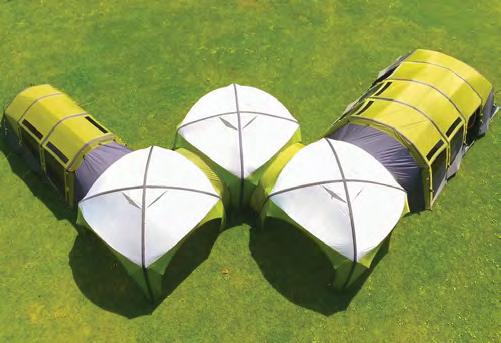

www.adventuresportsjournal.com 35
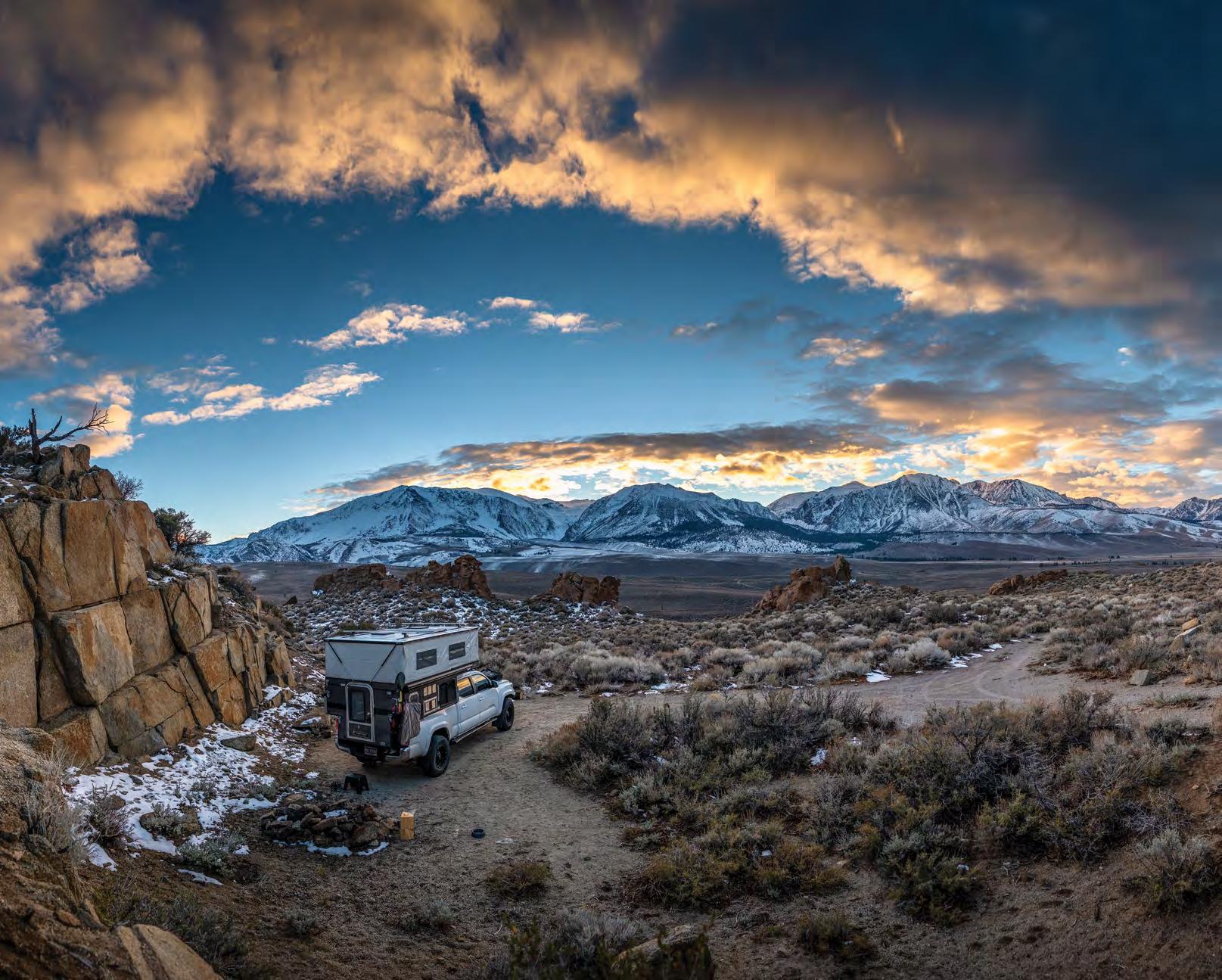




36 ASJ — June/July 2022




































































 — Matt Niswonger matt@adventuresportsjournal.com
— Matt Niswonger matt@adventuresportsjournal.com





































 By Krista Houghton
By Krista Houghton





























 By James Murren
By James Murren

























































































 By Leonie Sherman
By Leonie Sherman







































































